cmh
.401 Bobcat
  
Posts: 3,745
|
Post by cmh on Mar 12, 2015 23:39:58 GMT -5
Very cool  |
|
|
|
Post by Lee Martin on Mar 16, 2015 20:05:46 GMT -5
Scope Considerations – Part II _____________________________________________ In the first installment I outlined what benchrest shooters look for in a scope. Recapped in order of priority: 1) Dead rigid point-of-aim (POA) 2) Dead rigid POA 3) Dead rigid POA 4) Repeatable tracking 5) High magnification 6) Fine reticle (with or without a dot) 7) Lens clarity The repetition in 1 – 3 is not a misprint. If the scope won’t hold POA, the other four are meaningless. Repeatable tracking is a close second and ties to your shooting style. Most competitors hold off by adjusting their aim point. This is done by regulating the rest’s vertical and drift. Others make these adjustments with their scope. That method elevates the criticality of accurate tracking. I hold off on the paper and mainly dial vertical between 100 and 200 yards. Nevertheless, I want my optic’s movement to repeat time after time no matter the direction. While we’re on that subject, I’ll cover the validation process. The simplest way to do this is via the box test. Here’s how it works. In still conditions you put a round down range. That’s point number one. Then dial 40 clicks to the left or right, which equates to five inches at 100 paces (assuming 1/8” turrets). Fire a second shot. Click up or down 40 on your vertical turret and fire a third shot. Move windage another 40 and light off a fourth. Then return the vertical by 40 more and fire a fifth. What you should see is a perfect 5” x 5” box print with two bullets tight in the first hole. Obviously, one keeps the same point-of-aim throughout. You can push the test further by doing this in reverse. That is, if you originally went clockwise, adjust counter-clockwise on the subsequent four. Quality glass will do this on-demand (the size of the box or clicks made is up to you. I prefer testing well above 30 clicks. When tracking problems arise, they’re compounded the farther you move the erector) Shifting POAs is the seal of death for a benchrest scope. Earlier I covered some of the problems which plague off the shelf optics. The Tucker conversion was one way to better support the erector tube and wave washer. Another is Gene Bukys system which I’ll get to in a minute. But before going to these extremes, first determine if your scope is actually bad. For example, when groups become erratic or unwound and won’t dial back with load tuning, check: 1) The barrel. Is your cleaning regiment working or is the barrel near its end of life? The only way to precisely know is with a bore-scope. If still in doubt, re-barrel the action. 2) The bedding or glue-in job. Have you lost purchase from the adhesive bond or tensioning screws? 3) Is anything loose on the gun, such as your scope mount or rings? 4) Does the scope still track? Will it box test? Can’t shake these scope bugs or prove their existence? Send it back to the factory for expert analysis. Many Leupold owners mail theirs in for routine checks. Considering the unconditional life-time warranty, it’s no wonder they’re called UPS scopes. A friend and fellow benchrest shooter knows one of the leads in Leupold service. That individual claims a lot of these returns pass inspection with flying colors. And that isn’t a bad thing. I liken it to your routine physical. The patient doesn’t want the doctor to find a problem. They want reassurance or a passing grade and it’s no different with optics. That factory OK gives you peace of mind. But if it is sick, have them rebuild it to original specifications. A warranty doesn’t help you when the glass wanders in competition. Quintessential to benchrest is having the utmost confidence in your gear. It has to perform. When the shooter trusts the gun, he or she can focus on their job without distraction. Validating - rather than endure the downtime involved with warranty checks, a fortunate few use a Hood scope checker. This mount is simple, ingenious, and works by running two scopes in parallel. The first is known, the other is questionable. Each is sighted for a common point on the target and test shots are taken. Then you eyeball the reticles and see if they match the POI (fine graph paper is recommended). If one is off, the internals may have moved. I should stress though, the known entity must be accurate. Otherwise you have two dubious scopes and one hole. Which reticle is right? The out of production Hood scope checker:  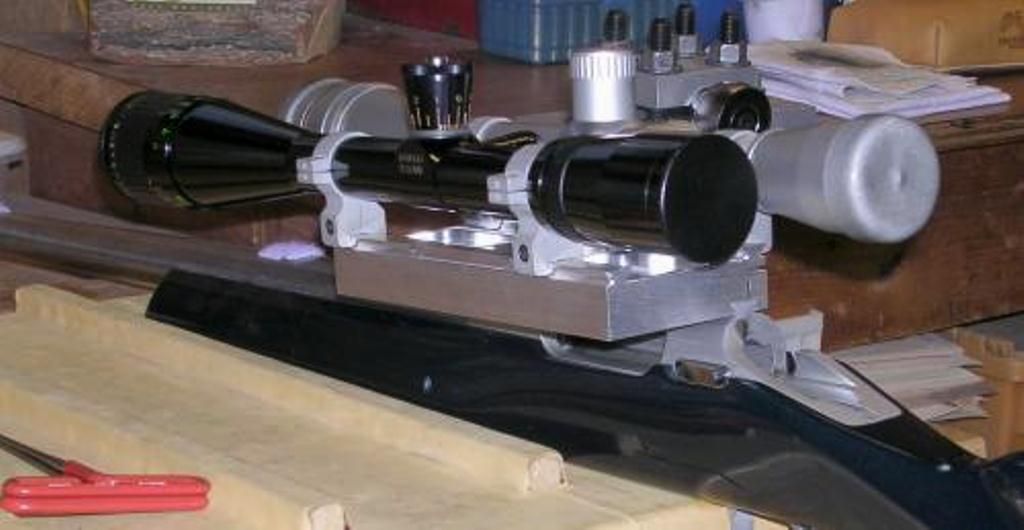 Gene Bukys got tired of wondering if his Leupold held POA. His solution was to lock the internals and mount it to an adjustable base. By removing the turrets and setting the erector with rigid inserts, the guts become frozen. All vertical and windage movement is done by the mounting system. The idea’s lineage dates back to the old external adjustment Unertls and Lyman Super Targets. 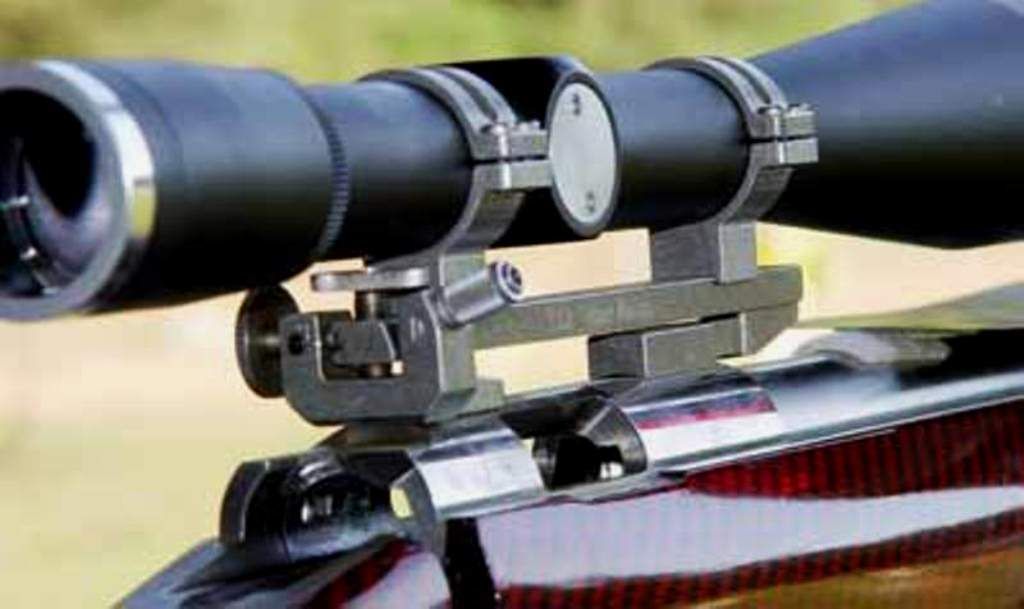 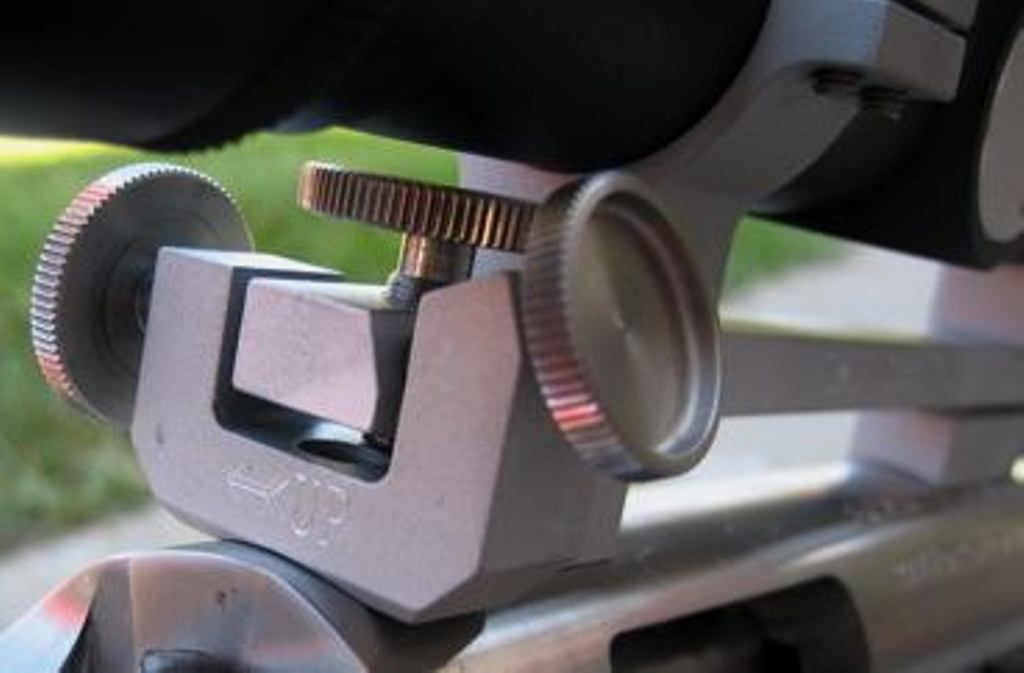 In large part, these workarounds solve the problem of minuscule POA shifts. Or better said, they minimize the risks found in even the finest competition glass. In the mid-2000’s a few died in the wool benchresters wanted a better mouse trap (though not widely publicized, I believe these men were James Kelbly, Turk Takano, Lou Mudica, Stewart Elliott, and Eric Stanton). They asked a simple question. In this day and age, why aren’t there optics designed and dedicated to meet BR’s stringent POA and tracking requirements? Their quest took them to Japan and what followed was one hell of a scope. To be continued. -Lee www.singleactions.com"Building carpal tunnel one round at a time" |
|
|
|
Post by Lee Martin on Mar 19, 2015 18:46:01 GMT -5
Reloading ______________________________ I’m shooting my light varmint rifle this weekend and photographed the case rolling. Whereas traditional loading is done in a press, benchrest employs in-line sizing and seating dies. I’ll cover the process extensively with the PPC but wanted to provide a preview. The equipment needed to load our .222 variant: 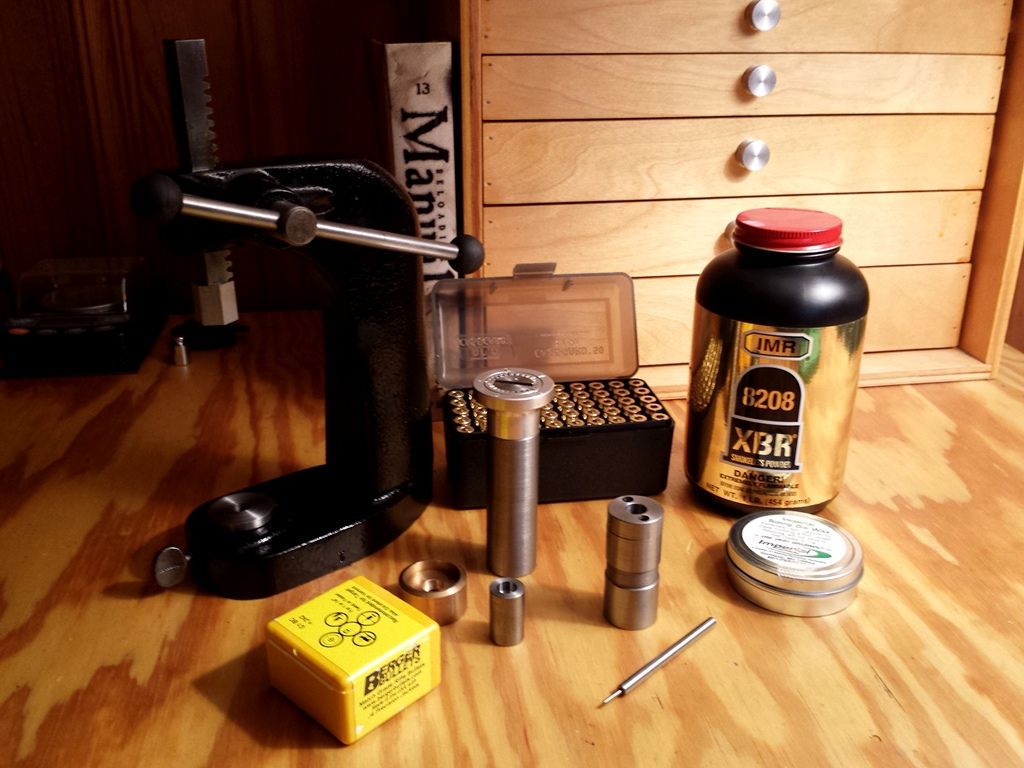 The FL sizer is homebuilt and contains a neck bushing. This one is 0.249” and gives around 0.002” tension. The body is minimally squeezed for tight chamber alignment; 0.001” at the base and less than a thou at the shoulder. Shoulder bump is also 0.001”. 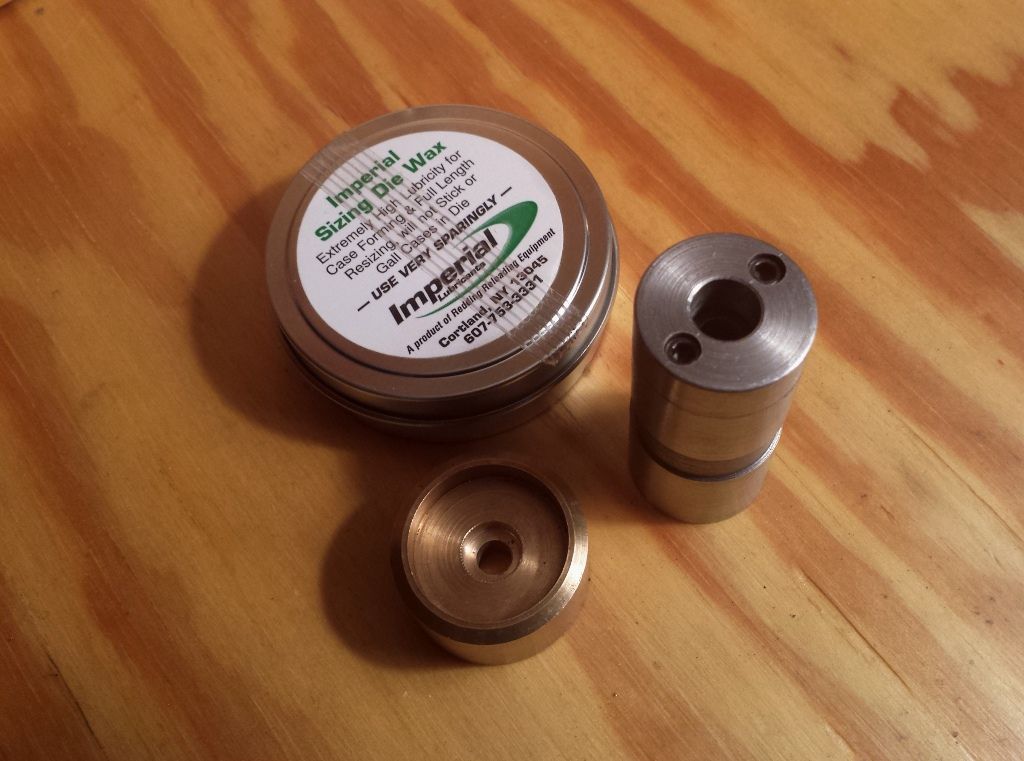 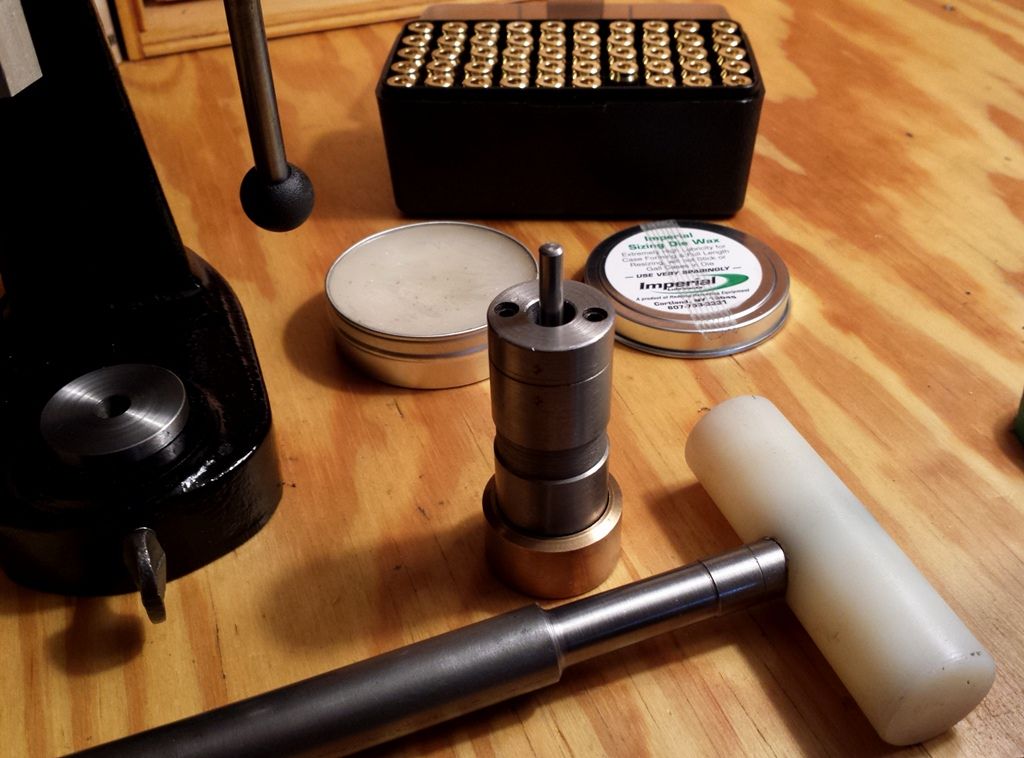 Shells are lightly lubed with Imperial die wax and the sizing is done in an arbor press: 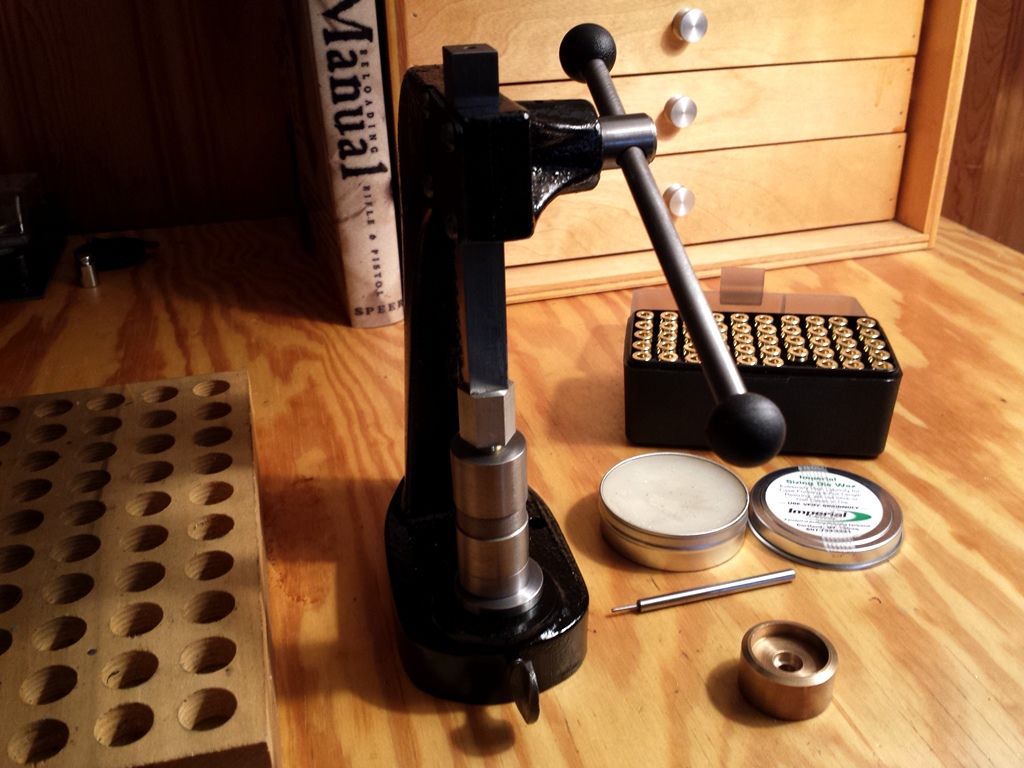  Here is a video of the sizing step: I like K&M’s hand-primer and CCI BR-4’s. Fancier tools are available but this model serves me well: 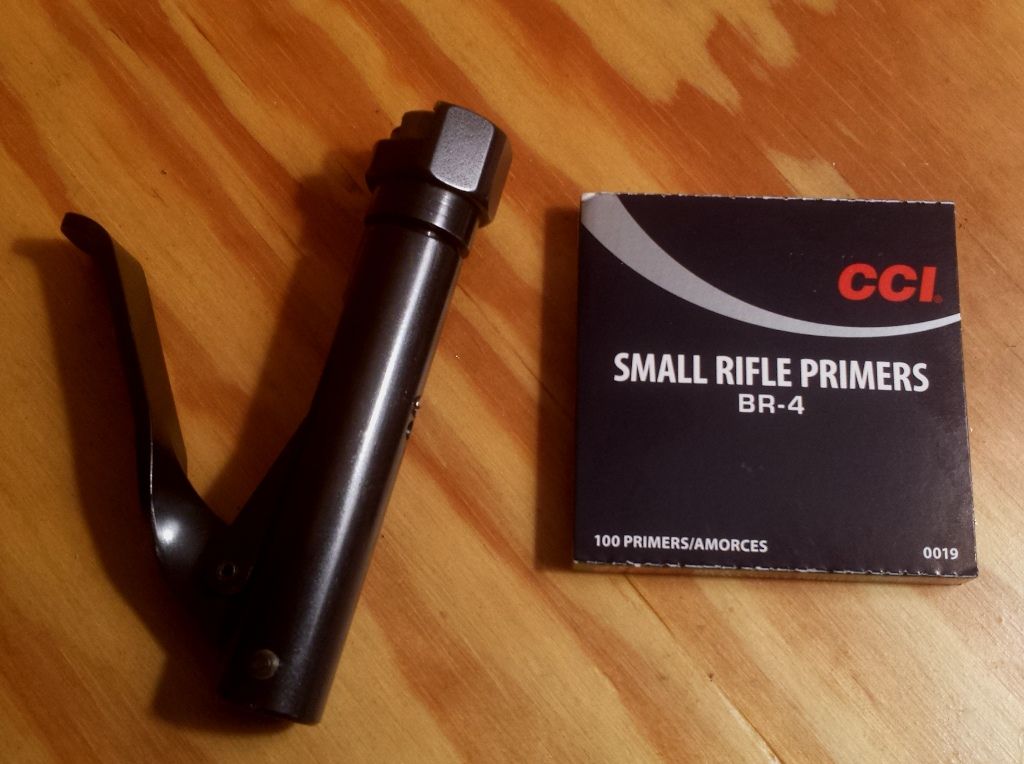 Powder is weighed on a GemPro 250 (accurate to a hundredth of a grain). Charges are thrown with an original Culver insert in a Lyman body: 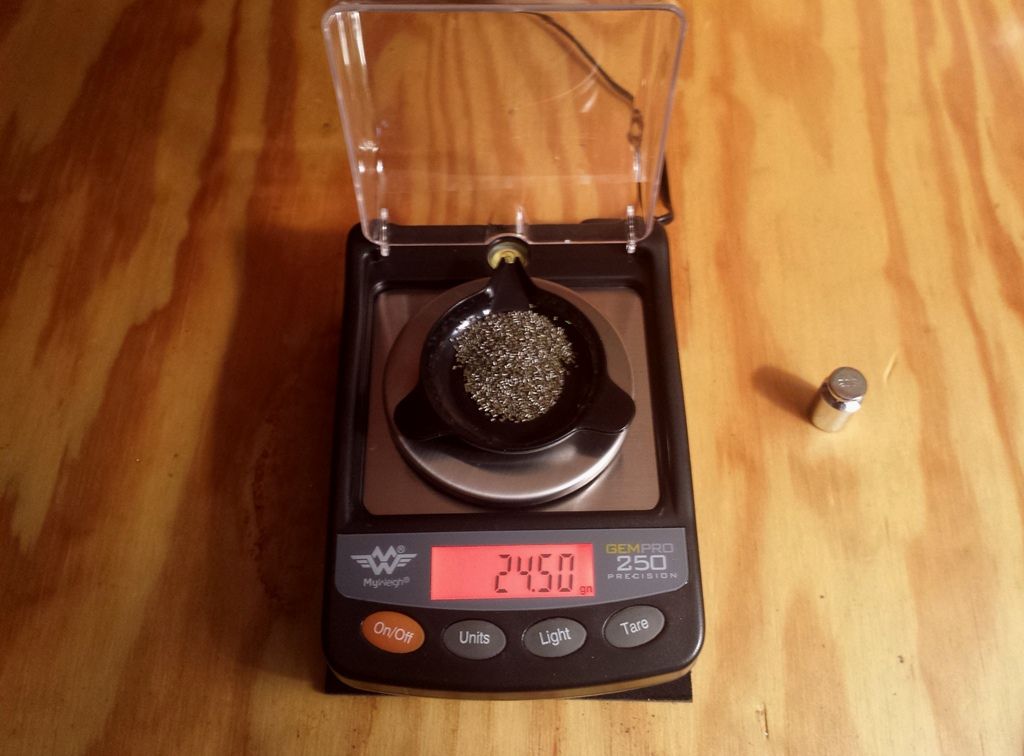 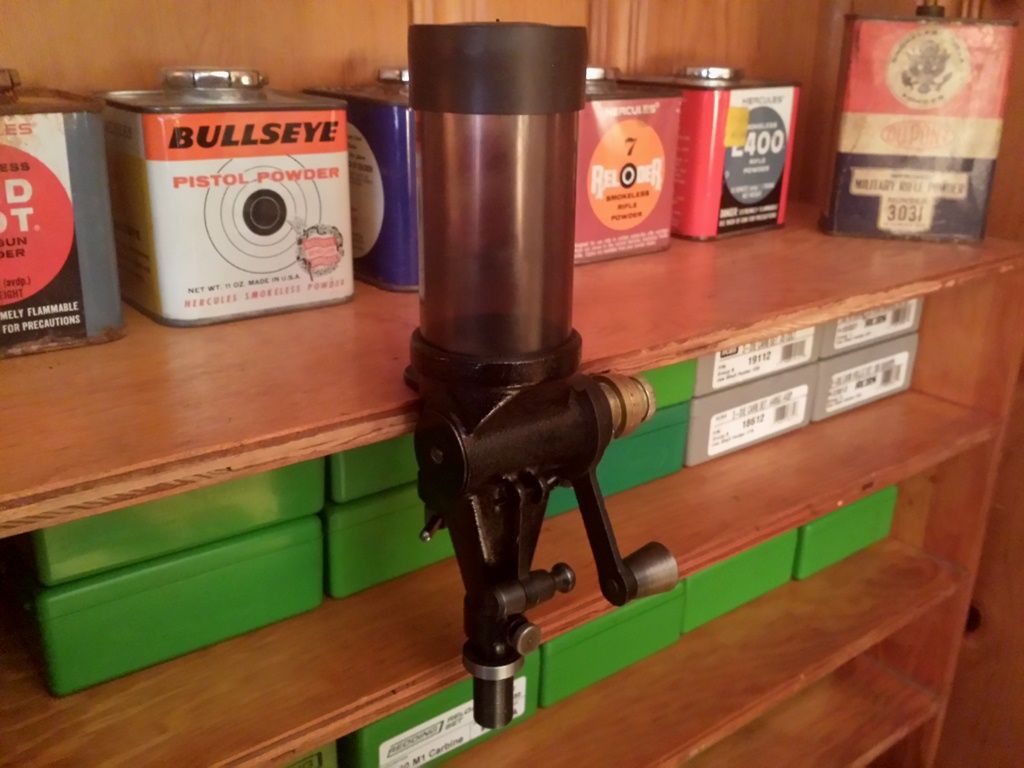 This weekend I’m using IMR’s outstanding 8208 XBR and a Berger 52 gr flat-base: 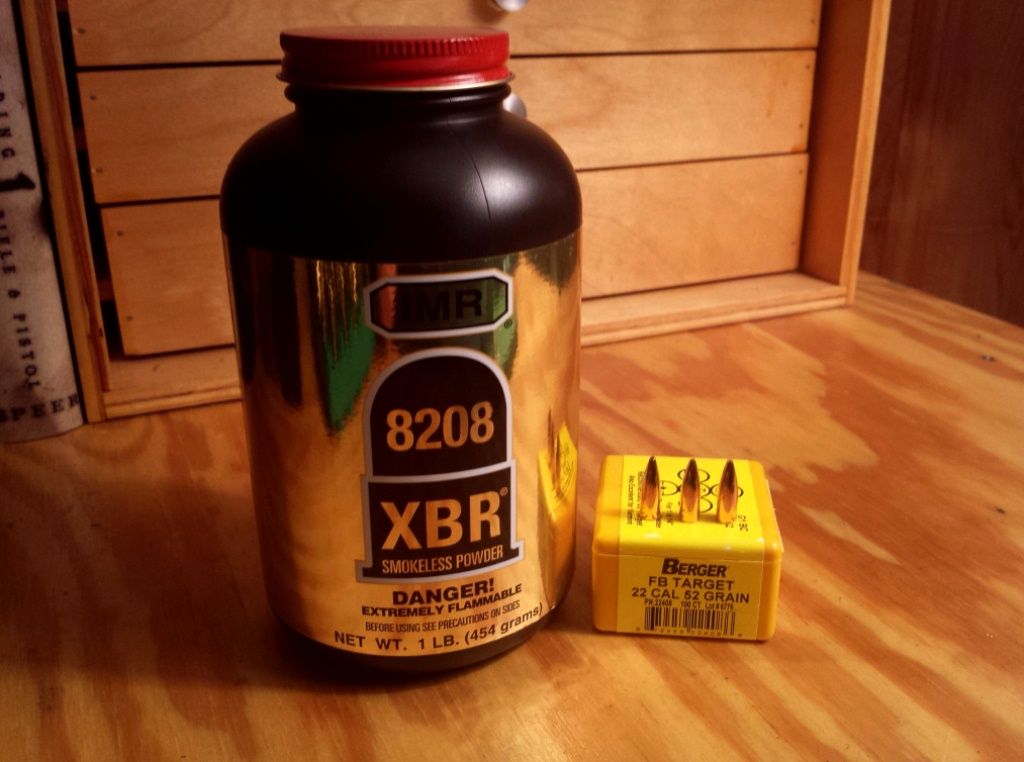 Seating is done with a Martin in-line die and micro top. Each tick is 0.002” on depth. Splitting the increments allows us to adjust within a thousandth. 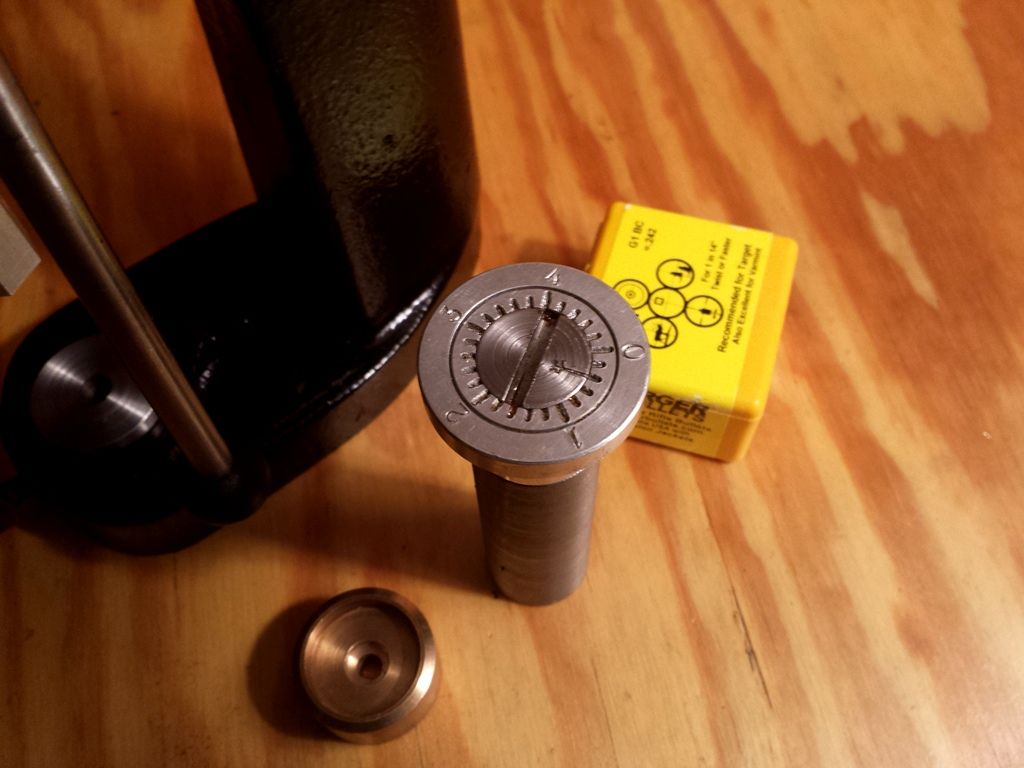 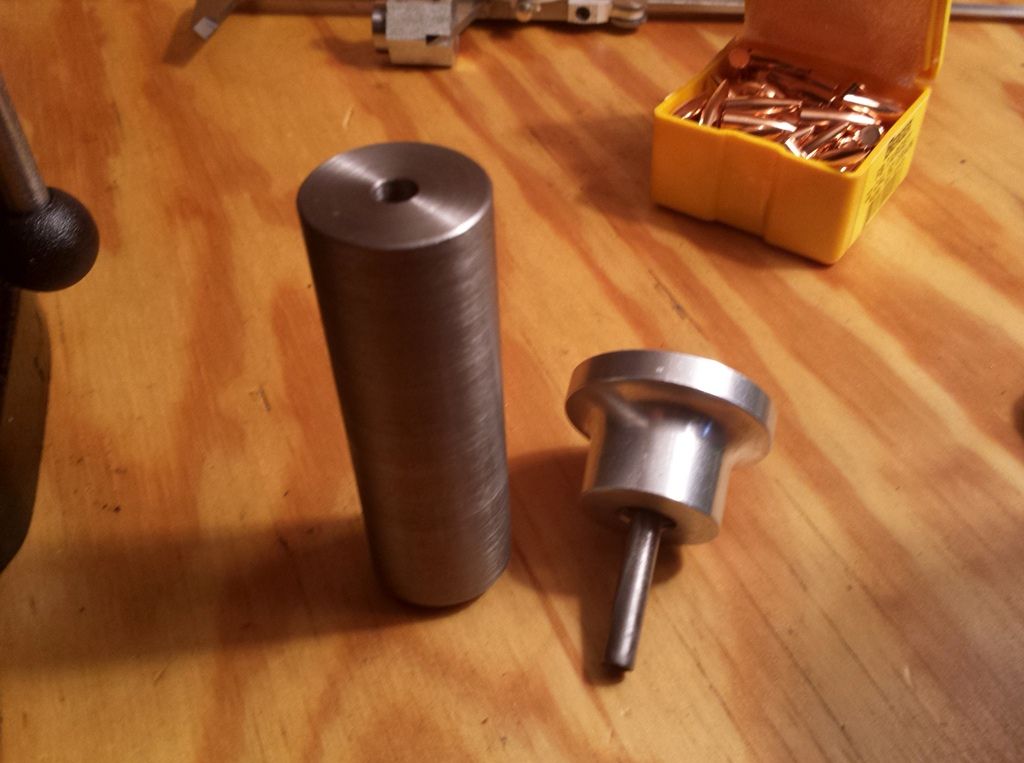 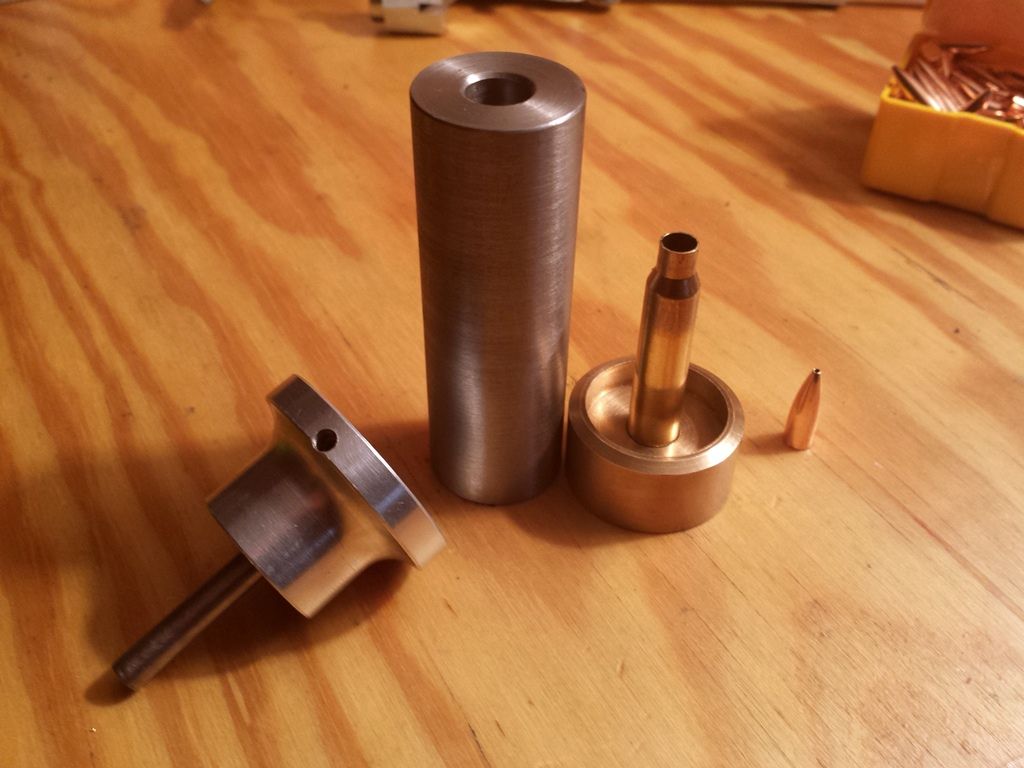 The arbor press applies the force. 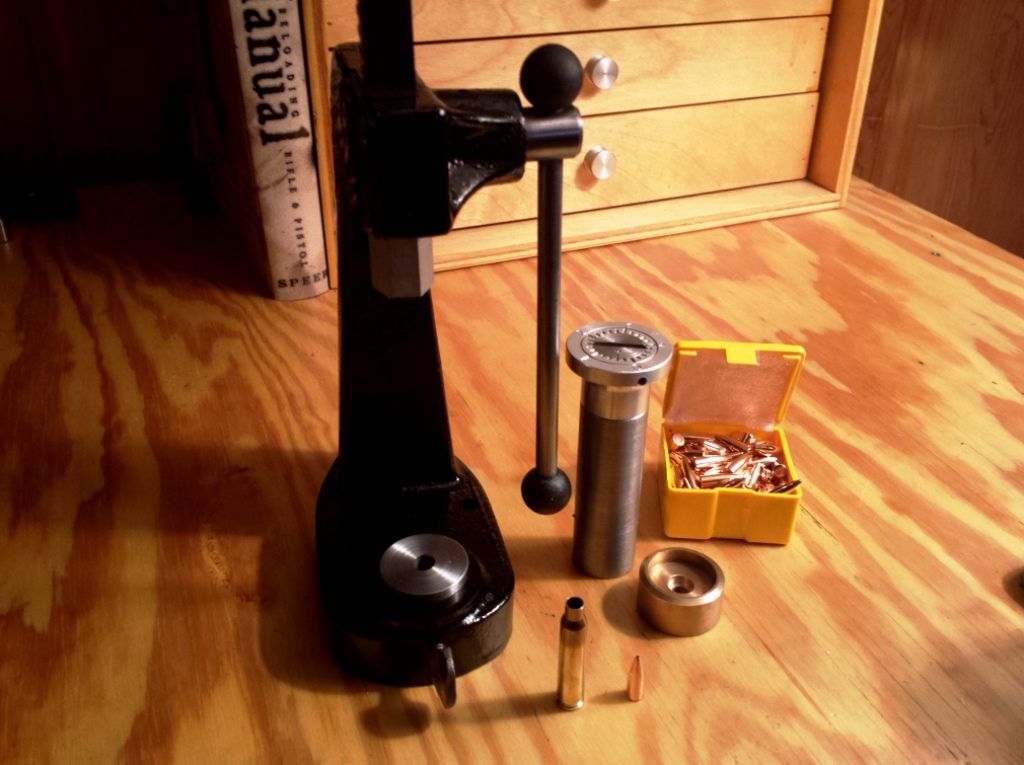 The seater is positioned so the bullet is 0.005” into the lands. A caliper mounted gauge measures the base-to-ogive and confirms this relationship to the rifling. 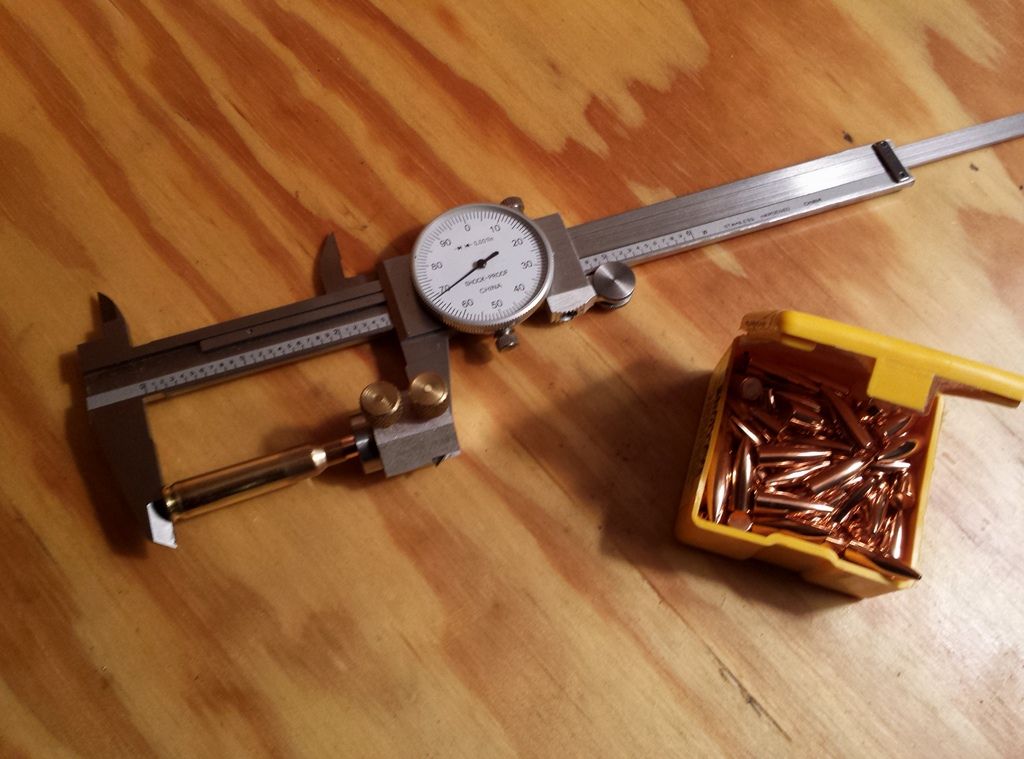 -Lee www.singleactions.com"Building carpal tunnel one round at a time" |
|
|
|
Post by Lee Martin on Mar 26, 2015 19:41:18 GMT -5
Final Scope Selection _______________________________________ The glass I alluded to in “Scope Considerations Part II” is the March BR by Deon. Based out of Nagano-ken Japan the company formed in 2004 by men with over 30 years in optical precision. This was no casual attempt at improving benchrest scopes. Job one was to eliminate aberrations such as POA shifts and inconsistent tracking. Compromise was not an option when pursuing this goal. They’d bolster the internals, reduce clarity issues which arise at high magnification, and do so within varmint class weight brackets. Applying technical prowess in the hope it’d be well received was avoided. Instead, they emphasized end-user input by flying top benchrest shooters to Japan. Reputed white board sessions were held and with requirements in hand Deon went to work. This culminated with the March 40x52mm BR in 2006. It was instantly embraced by some of the biggest names in the sport to include Tony Boyer. A year later the scope helped secure wins at the Cactus, Super Shoot, World Championships, NBRSA 4-gun Championships, NBRSA 200-300 yard Nationals, and the NBRSA 1000 yard Nationals. Admittedly March was a small part of the equation. The experience of those adopting them was the deciding factor at these events. Yet their quick acceptance was telling – a better mouse trap had arrived. Eight years later a few known March shooters say their aggs have shrunk 0.003” – 0.006”. A bold testimonial since they’re pinning this on the glass alone. But keeping in mind the HOF points behind the claim, it’s a hard one to challenge. Why are March scopes so well suited for BR? • High durability – no plastic parts and the main tube is machined from billet aluminum • Rigid POA – erector support is through ball detent and coils as opposed to flat springs • Lenses are permanently bonded and assembled scopes are filled with Argon gas • The turrets are individually hand lapped into place to ensure a perfect fit • March lenses employ special ED technology designed by Deon. They offer extra low dispersion, similar to that found in professional grade Japanese cameras and microscopes. These lenses greatly improve image resolution. • 72 MOA elevation travel even above 50X • Each scope is hand assembled and rigorously QA’d. March produces a wide range of fixed and variable magnifications; the uppermost being an 8–80x56mm tactical:  The models ordinarily used in BR are the set 40, 50, or 60x followed by the variable 36–55x52mm. My eyes are still good so I chose the 40. Extra power aids in pinpointing your hold but mirage becomes a greater concern. Reticles are fine-cross hair or fine with a dot (1/16, 3/32, or 1/8). 3/32’s are easy to pick-up in low light conditions and mate well with the 10 ring X’s in score. But quality notwithstanding, March has one drawback and that’s the cost. They start around $2,400 and can quickly move to $3,200. Pricey but if I’m in the game for the long haul I’m buying the scope once. Or as my dad’s friend used to say, “Pay a little more, get a little more”. My new 40x52mm March with 3/32 dot reticle: 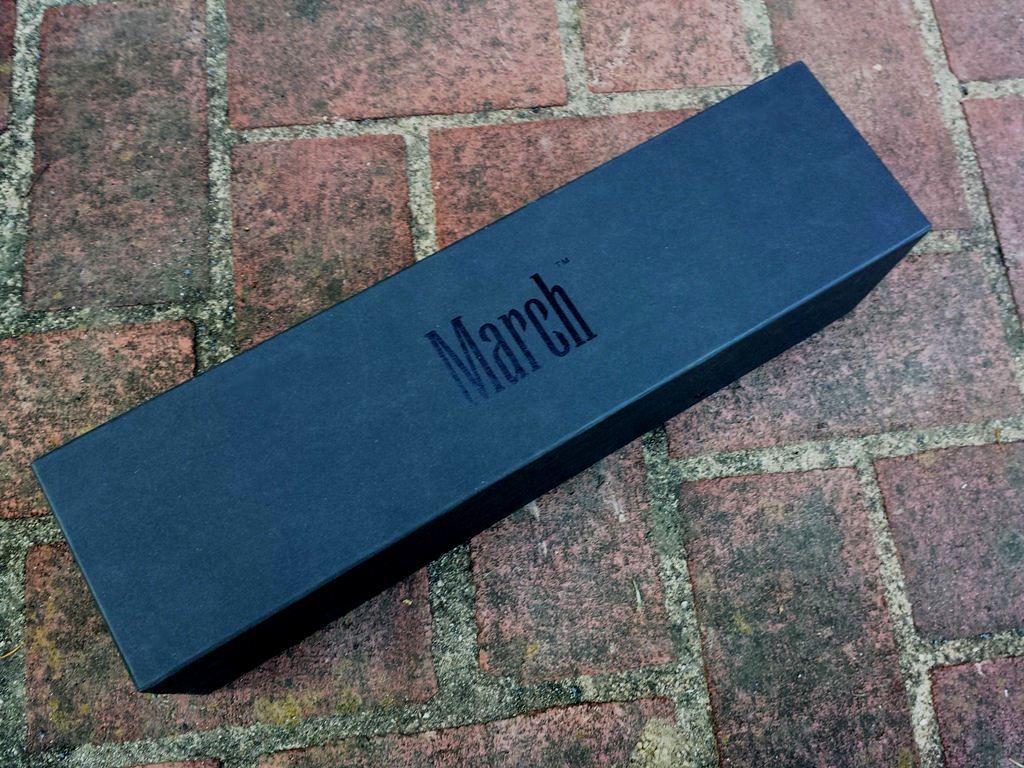 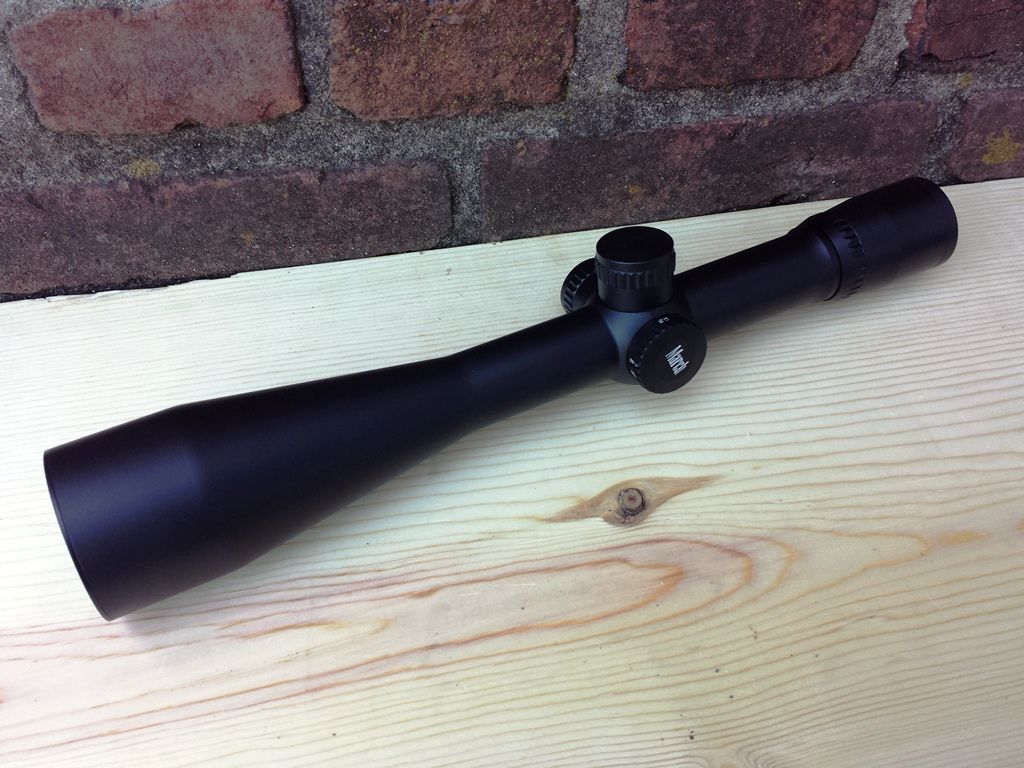 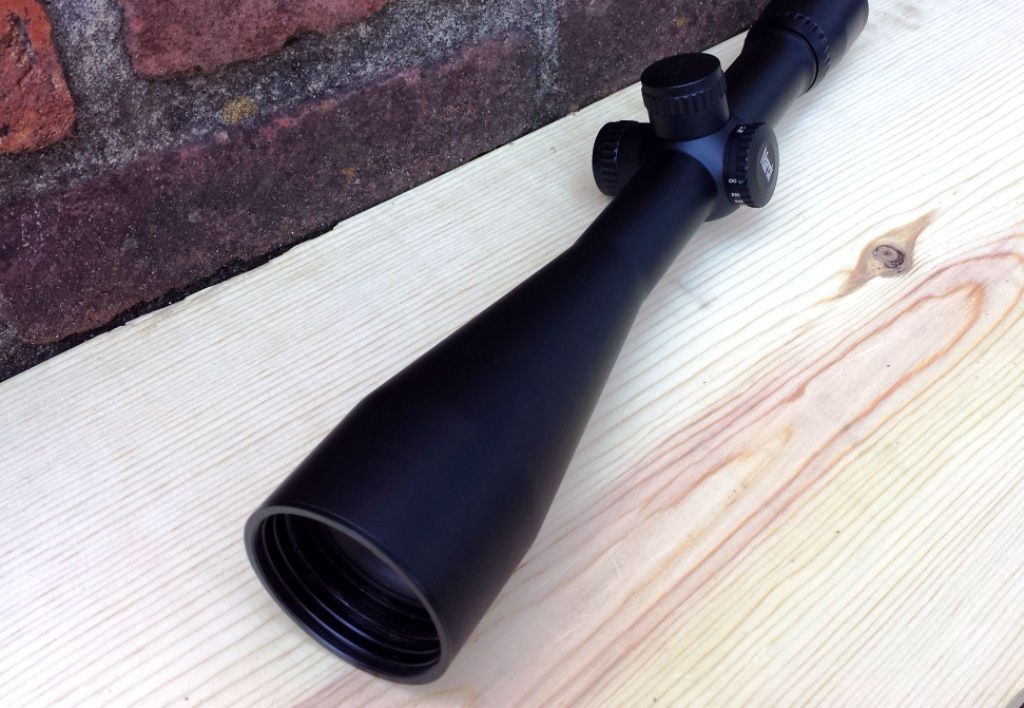 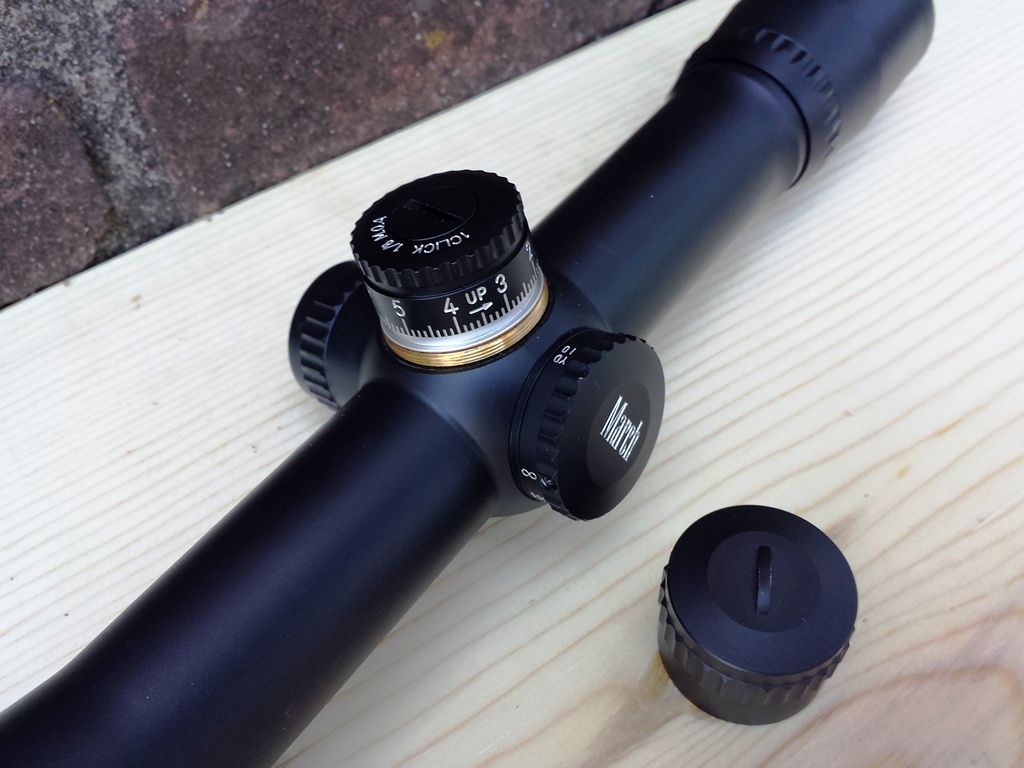 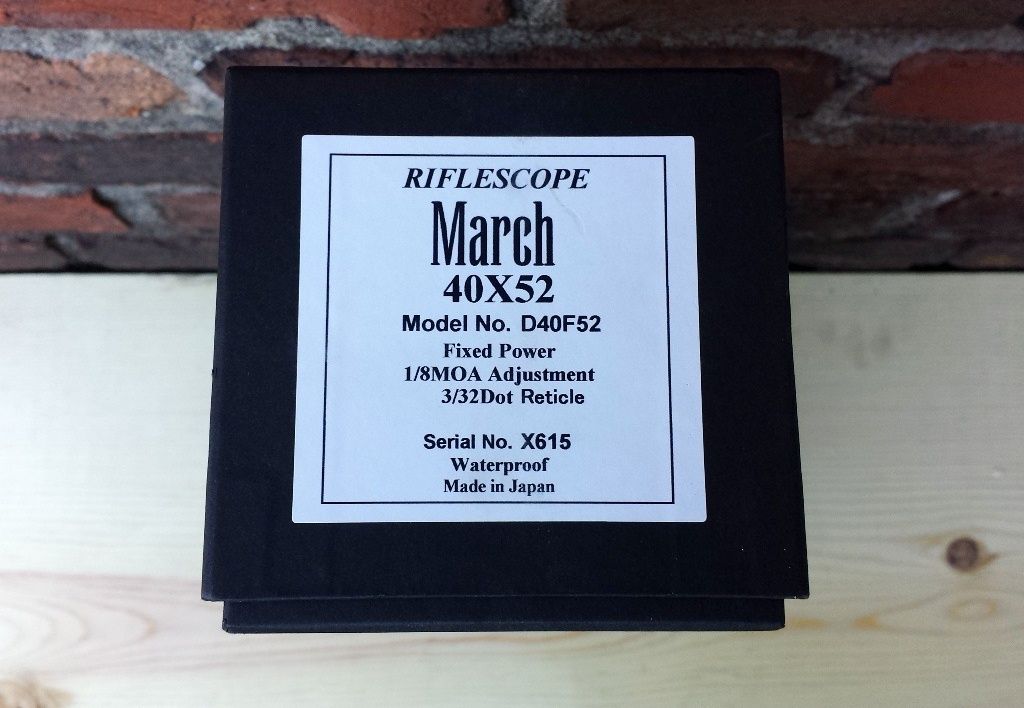 Spec Sheet: • Magnification – 40x • Objective – 52mm • Body - 30mm • Exit Pupil – 1.3mm • Adjustment – 1/8 MOA turrets • Paralax – side mounted • Focus – 10 yards to infinity • Reticle – fine cross hair with 3/32 dot • Weight – 20.8 oz The added benefit with the March is its weight. 20.8 ounces is manageable and matches Leupold Competitions. It’ll make scale on light varmint guns and has done so since ’06. On the contrary, some leading brands have had trouble penetrating short range BR. Weights in excess of 30 ounces hinders them from working in light varmint. Nightforce is one of those companies. Their 12–42x56 is a fine optic but its 29 – 36 ounce payload doesn’t play nice in the 10.5 lb class. You’ll find them on heavy varmint group and score rigs, but not in the growing 2-gun field. The same applies to other makes, most of which are variable and geared towards tactical segments. They’re simply too heavy or don’t come with a reticle appropriate for benchrest. My 40X has been bi-directionally box tested and the tracking is beyond compare. Lens clarity is also the finest I’ve experienced over 36 power. The images are sharp, bright all the way to the edges, and the focus is crisp. This scope may have cost a bundle, but so far it seems like money well spent. A factory photo of their 3/32 dot, fine cross-hair reticle:  March 36–55x52mm  This’ll give you an idea of what a 60 power lens does at 1,100 yards. 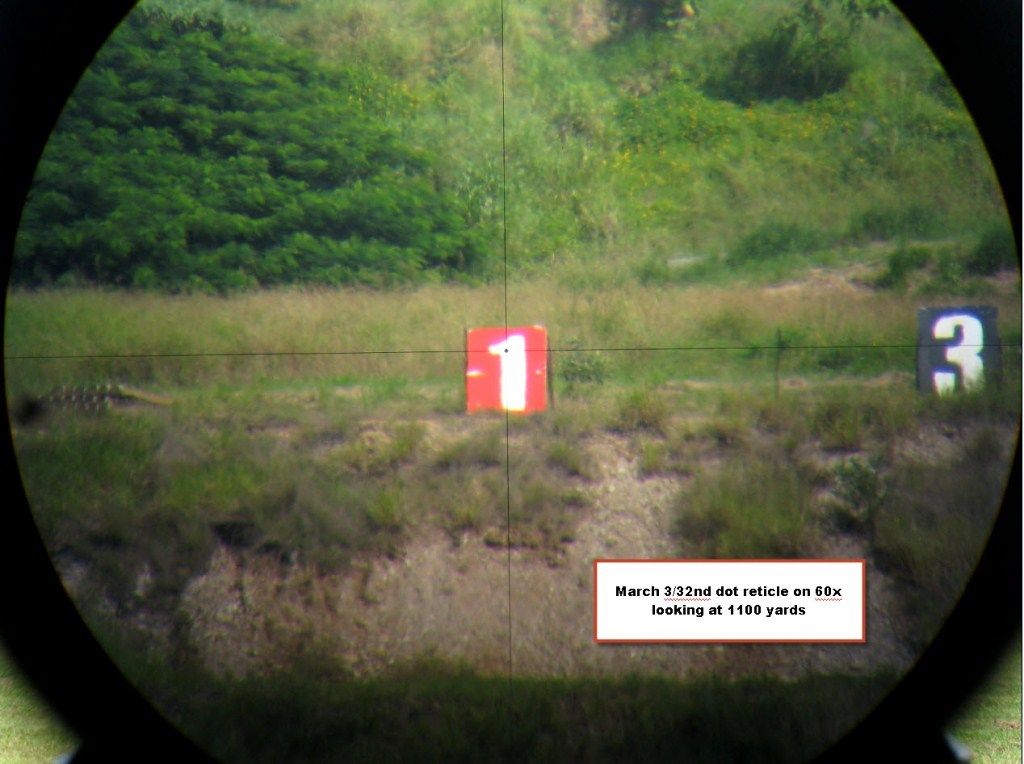 If you’re interested in a March there’s only one stateside distributor - Kelbly Rifles out of North Lawrence, Ohio. You could say they’re the first family of benchrest with George’s involvement dating back to the 1950’s. They took over production of the Stolle Panda action when Ralph died and they host the annual Super Shoot in May (the pinnacle event for group BR in the U.S.) Additionally they manufacture benchrest stocks, scope rings, and even triggers. -Lee www.singleactions.com"Building carpal tunnel one round at a time" |
|
|
|
Post by 2 Dogs on Mar 27, 2015 8:44:44 GMT -5
YIPES! March optics!! We are getting spendy now!!!
|
|
|
|
Post by Lee Martin on Apr 1, 2015 18:37:59 GMT -5
The Stinnett Record __________________________________ For forty years the 100 yard group world record was by held by Millard “Mac” McMillan. Shot with a prototype action and an early McMillan stock, Mac took his light varmint .222 and stuck five bullets in a 0.009” spread. This occurred in NBRSA competition on September 23, 1973 at the Skunk Creek range outside of Phoenix. The event also coincided with Mac’s 58th birthday. Here is a photo of the actual target: 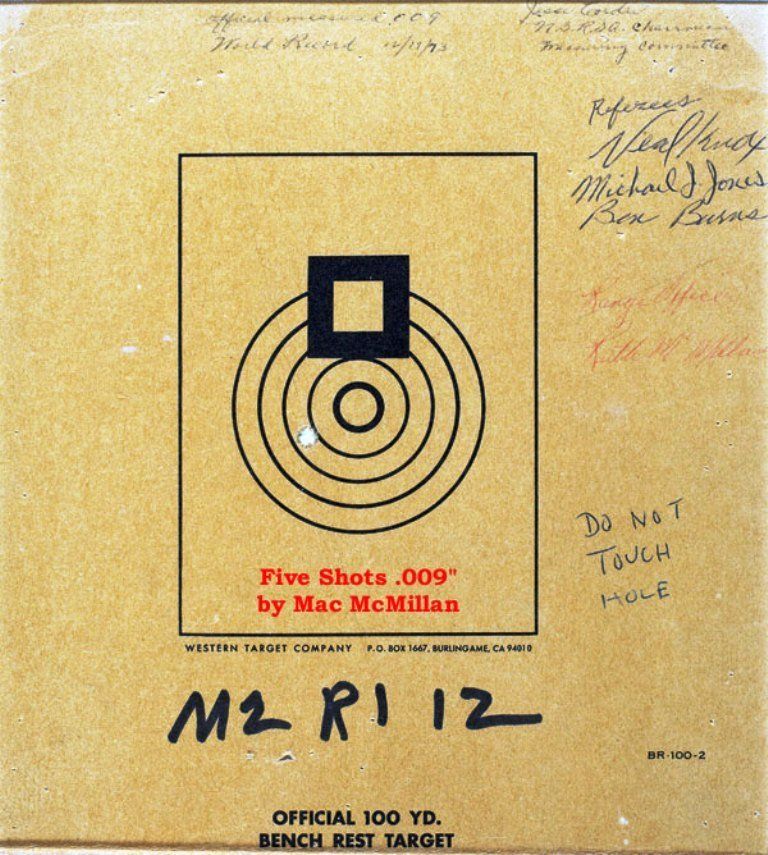 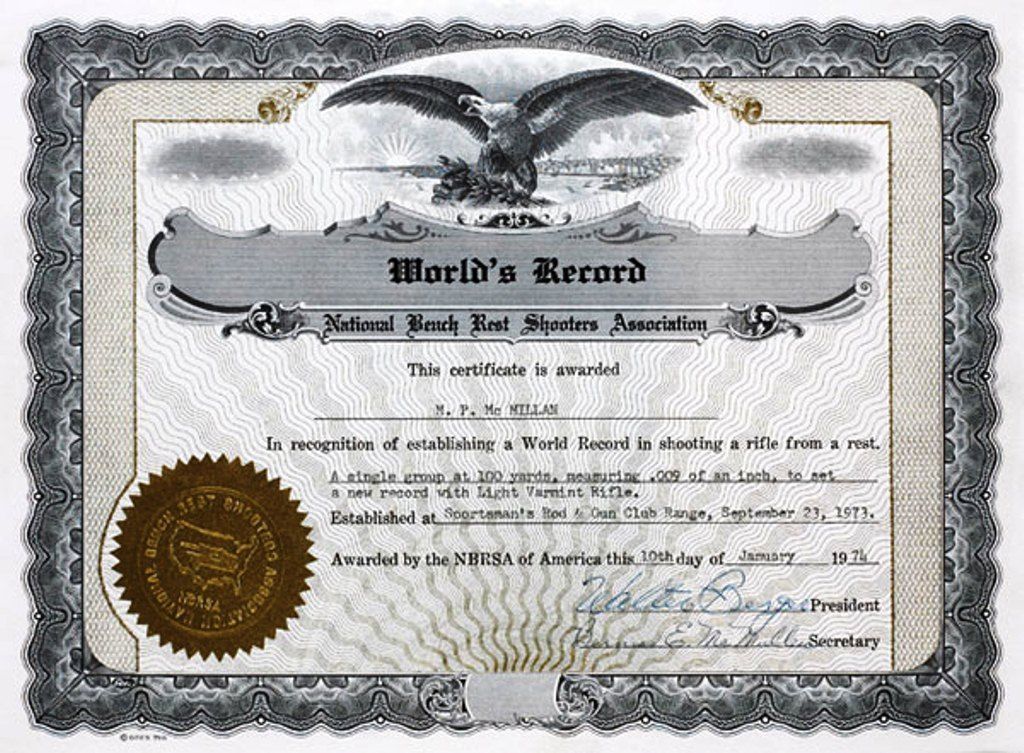 All three McMillan brothers had a hand in building the gun. Mac machined the action, Pat was credited with the barrel, and Gale crafted the stock (side note – Mac made this barrel, along with the first McMillans. He turned the technology and the process over to Pat in the early 70’s). His scope was a 12X Leupold which Wally Siebert boosted to 24X and the bullets were home grown. Pat McMillan’s own die pointed the 50 grain FBs on J4 jackets and 23.5 grs of BL-C propelled them. The components themselves were all quasi-prototype. Hodgdon Lot No. 1 of BL-C was poured over an experimental CCI small rifle primer. Shortly thereafter CCI released their BR-4. The history of the McMillan commercial ventures is often mistold. Gale was the stock man and made his first fiberglass unit in 1972 on a kitchen table. In 1973 he opened McMillan Stocks and ran it alongside G. McMillan Co. until 1987. The latter was Gale’s action and rifle line, much of which was under government contract. That division was sold to Harris Gunworks in ’87 and was backed by German investors. However Gale still controlled McMillan Stocks with his son Kelly at the helm. Kelly would eventually team with his brother Rock and establish McMillan Brothers Rifle Co. Gale McMillan, 1930 – 2000: 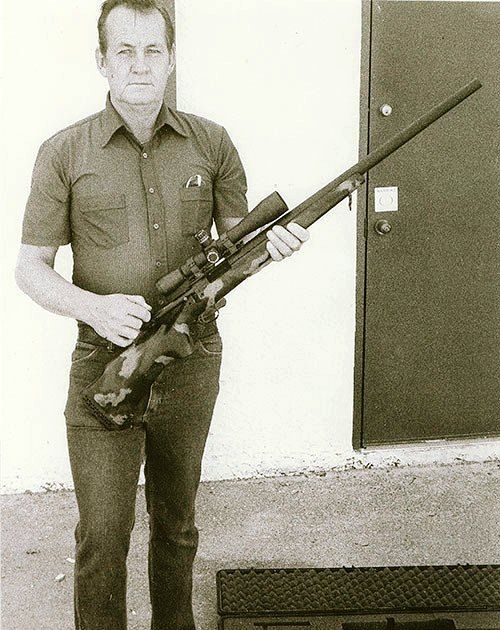 Pat McMillan on the other hand was a renowned barrel maker. His brother Mac actually rifled the first few and this led to Pat’s business. That’s probably why Pat’s name is tied to the record gun, even though it was Millard’s tube. Throughout the 1970’s, Pat McMillan barrels had terrific success in competitive benchrest and their reputation grew. Then in 1983 he sold the interest to a retired Marine Master Sergeant named William Wiseman. Bill has carried on the tradition of quality and innovation by specializing in SAAMI pressure test receivers and barrel systems. Alright, back to the record group. First, it happened under pretty harsh circumstances. Spurts of high wind and changing intensities came from 8:00 on the shooters’ backs. Second, Mac had a hard time finding a similar condition to fire the last shot. At the half minute call he waited another 10 to 15 second and let go. What they saw through their spotting scopes shocked them. The paper was pulled and the shock changed to elation. Judging by the eyed dot alone they knew it may be a record. Match officials immediately used a dial caliper and plexiglass .22 caliber reticle to measure it. That combination showed a 0.224” entrance, or 0.000” center-to-center. The target was next sent out and assessed using a 60X microscope with resolution to 0.0001”. Again, it indicated all five went into the same spot with no dispersion. Had the perfect group been realized? It was up to the NBRSA record committee to decide its fate. Armed with less sophisticated devices, they landed on an average measurement of 0.233” at the widest point. Officially McMillan’s group was a 0.009”. For decades Mac’s group fueled bench talk, rumors, and even controversy. Many believe it was a perfect zero. They feel the NBRSA called it 0.009” as to not squelch the pursuit of perfection. Others question its validity, citing problems with the motorized backer (the moving stream of paper that confirms the group). Yet one thing rarely argued was how long it would stand. When it went into the books under one-hundredth of an inch, folks deemed it unassailable. The previous record was 0.054”, or six times as big. To that end, did it really matter if it was 0.000” or 0.009”? 39 years and 9 months later it mattered. On June 8, 2013 Texan Mike Stinnett shot a 0.0077” in registered competition. The target was examined by multiple scoring committees and confirmed. Mac McMillan’s untouchable 0.009” had fallen. As important, it did so without skepticism or question. Mike Stinnett’s record target: 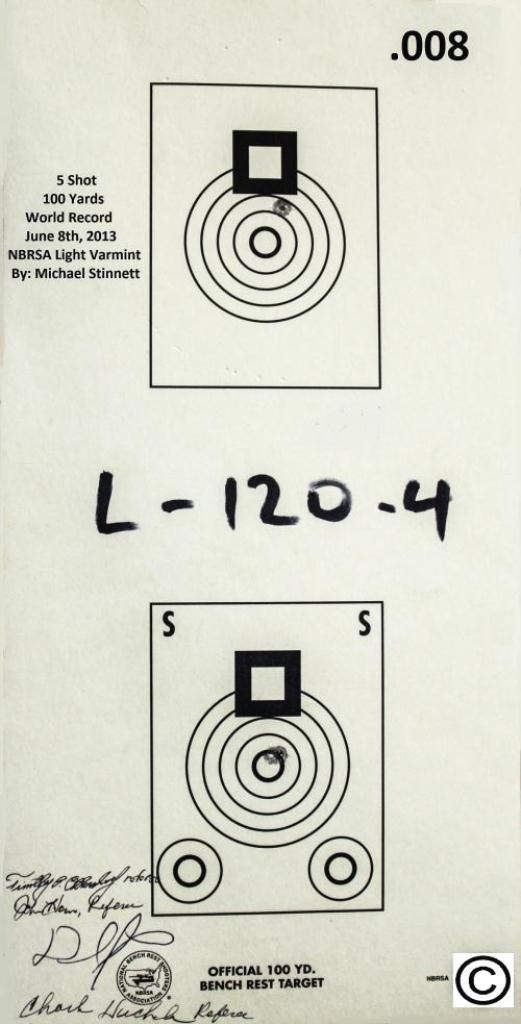  In his own words, here is Mike’s equipment list: • Cartridge: 30 PPC • Action: Kelby Panda “Speedy Shorty” with Solid Bolt – PPC Bold Face. Kelby was asked to build several actions which were identical with the intent to eliminate any variance in head space between the two new rifles. This helped me use a single setup on sizing dies for both rifles and ammo is interchangeable. Both actions were sent to “SPEEDY” to be blue printed along with new Jewell Triggers which were matched to the actions. • Stock: Larson (including action bedding). • Barrels: Krieger was selected for the barrels and after discussions with Randy Robinett (BIB Bullets) a 17 twist was identified as the correct safe solution. Ralph Stewart has cut all my chambers using a custom designed reamer. Again the concern was consistent headspace and Ralph has been able to keep my barrels within 0.0002 variance. • Scope: Leopold 45X Competition • Rings: Kelby Single Screw Tall. • Flags: Graham Wind Flags (large). • Tuner: Ralph Stewart • Front Rest: Farley • Bags: Micro Fiber • Brass: Lapua (Base case is 6.5 Grendel) • Bullets: Randy Robinett (BIB) 30 Cal. 114gr. 10 Ogive (my secondary – primary is 112 gr.) • Powder: H4198 – Weight?? (You can’t get that much in a 30PPC!) Velocity – 2980 FPS • Reamer: 30 Stewart (I just call it a 30 PPC as that is what everyone expects, but it is in fact a custom design and Ralph deserves about 99% of the credit). • Dies: Sizing – Hornady Custom Shot / Seating - Ralph Stewart Custom Mike’s record setting rifle:  They said McMillan’s 0.009” would stand forever. That all changed in 2013 with Stinnett’s 0.0077”. Will we see it broken again? Anything is possible, but if I were a betting man my money would say not in my lifetime. By the way, Mac’s target and rifle are on display at the McMillan Museum. I hope to see them someday when I’m out west. -Lee www.singleactions.com"Building carpal tunnel one round at a time" |
|
ericp
.327 Meteor
 
Posts: 521
|
Post by ericp on Apr 2, 2015 6:27:54 GMT -5
Great history lesson! It would be interesting to see what changes were made to the PPC reamer to come up with the 30 Stewart and hear the reasoning behind them.
Eric
|
|
|
|
Post by Lee Martin on Apr 6, 2015 19:48:32 GMT -5
Great history lesson! It would be interesting to see what changes were made to the PPC reamer to come up with the 30 Stewart and hear the reasoning behind them. Eric Mike Stinnett never published the reamer but I do know the Stewart is principally a .30 PPC. The main difference is he uses 6.5 Grendel as the base versus .220 Russian. Most of the other changes are in the throat dimensions. This was done to match his longer 10-ogive bullets. -Lee www.singleactions.com"Building carpal tunnel one round at a time" |
|
|
|
Post by Lee Martin on Apr 6, 2015 19:53:21 GMT -5
Case Forming – Step 1 _________________________________________ While I wait for the action to return I began forming brass. I’ll outline the steps in the coming posts, but will say there are few ways to make 6 PPC. I favor neck expanding, neck turning, trimming, fire-forming, and then re-trimming. Others take .220 Russians, fill them with powder, wax plug the end, and fire-form. Turning to the desired wall thickness and trimming to length completes the process. Most PPC shooters start with Lapua .220 Russian. Norma released factory 6 PPC in 2011 and the reports are good. They eliminate having to upsize to 6mm and uniformity is superb. However, Norma is softer and for that reason I selected Lapua Russian: 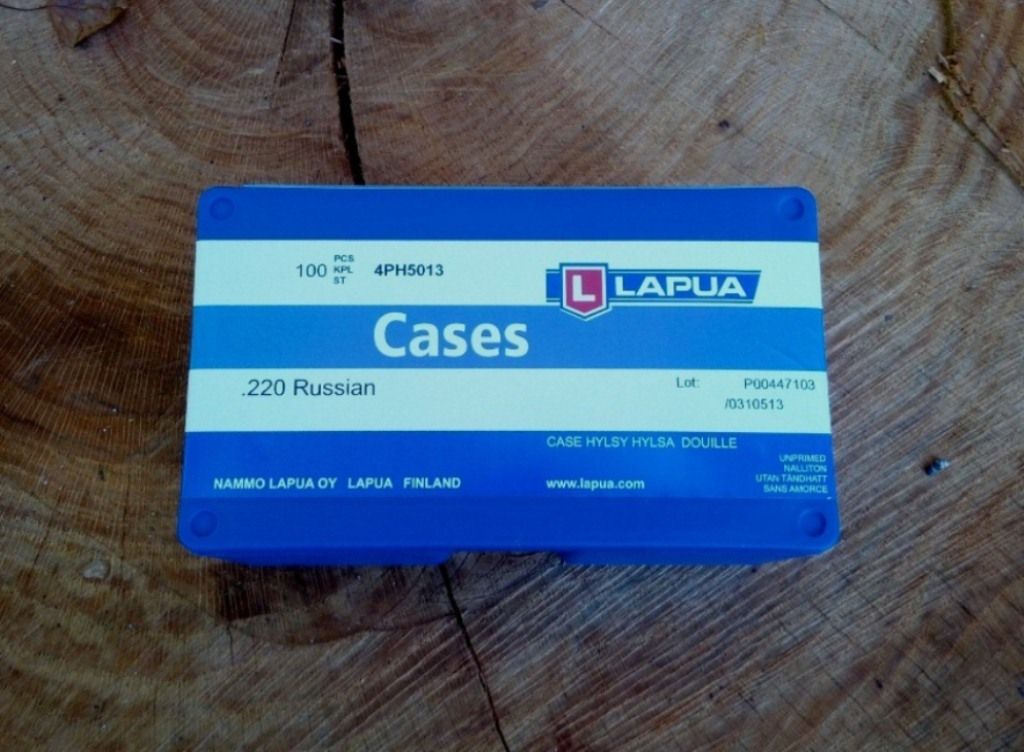 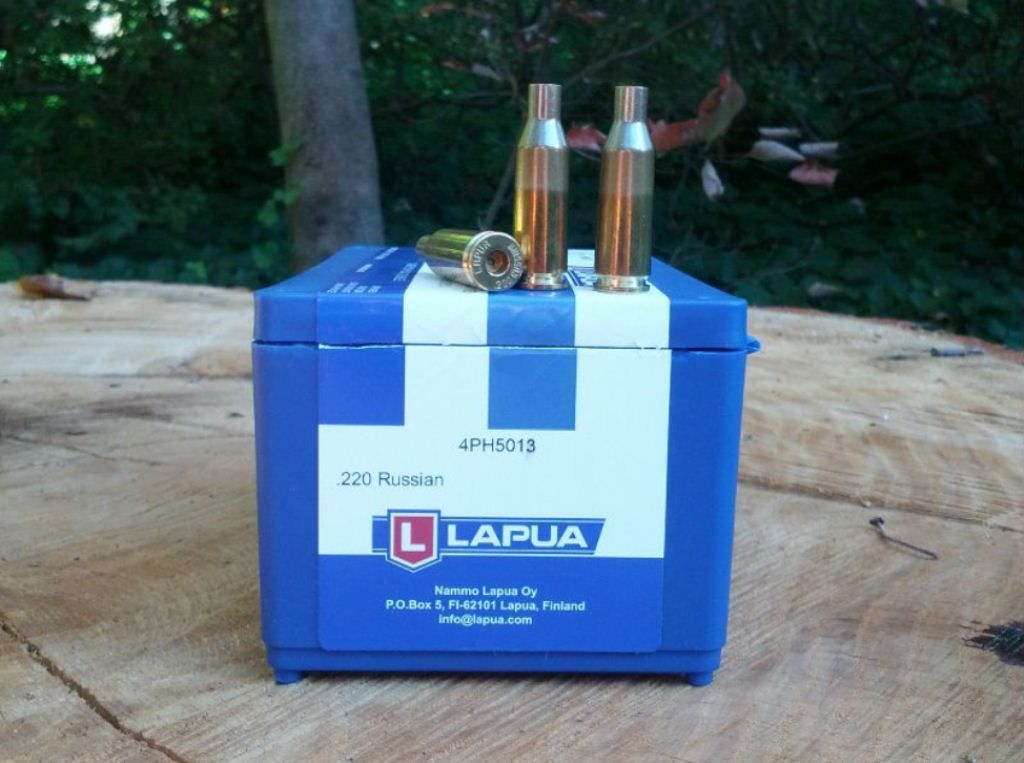 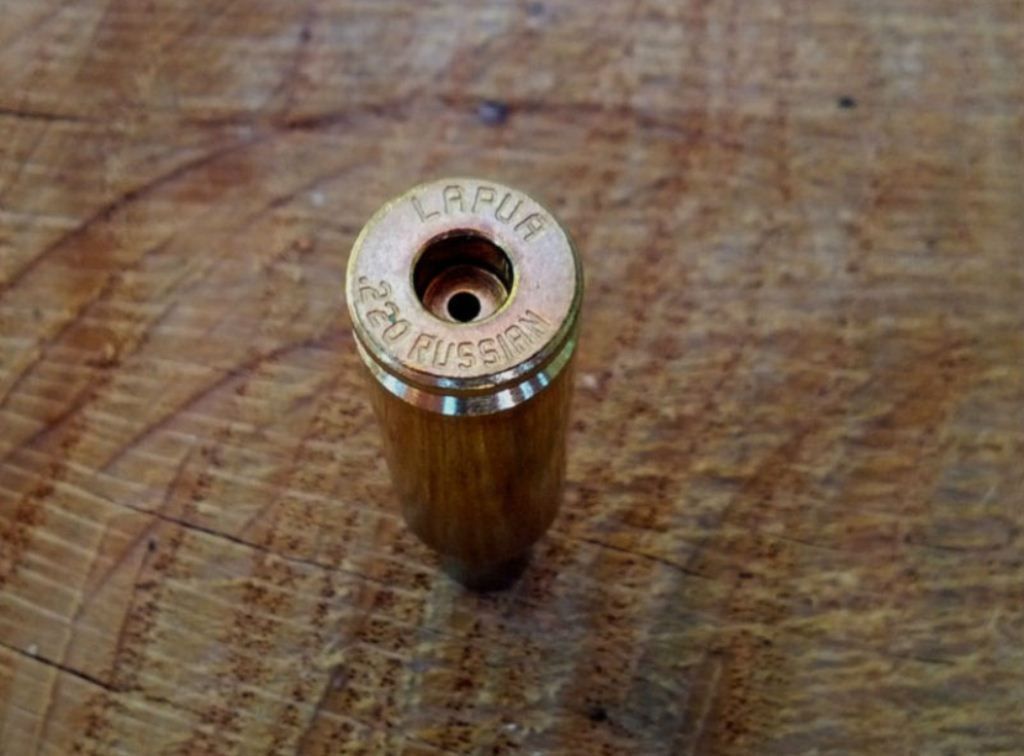 Each case is weighed on a GemPro 250 electronic scale. These units are quite sensitive and have resolution to two-hundredth of a grain. They even feature an integral level for proper placement. 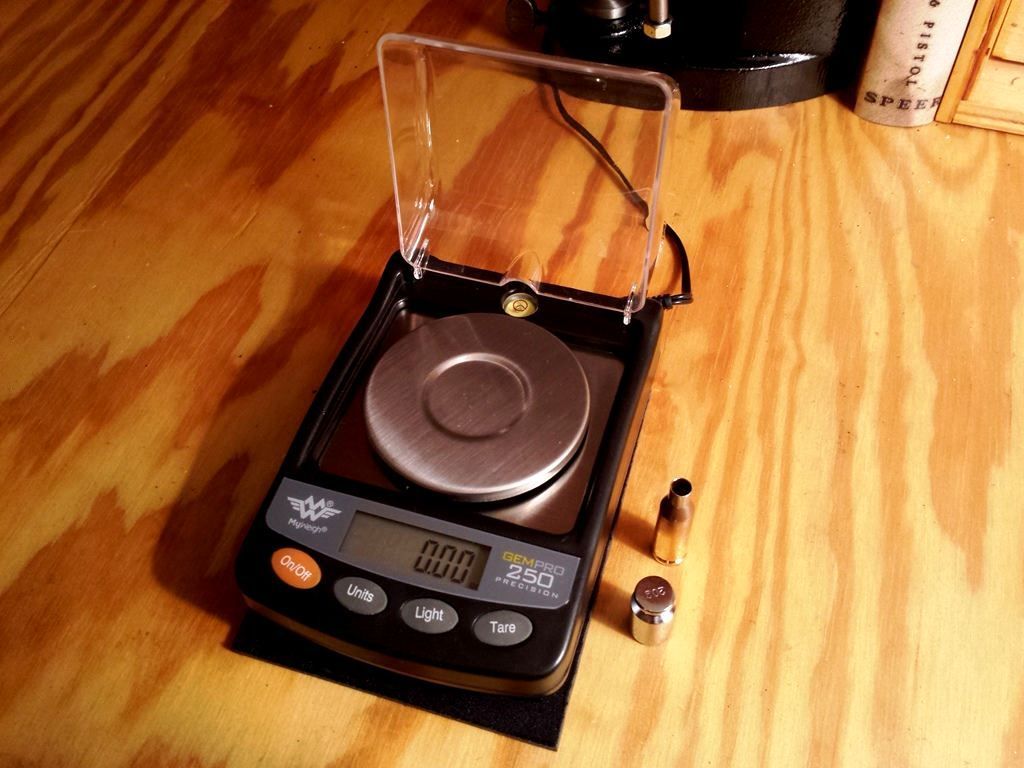 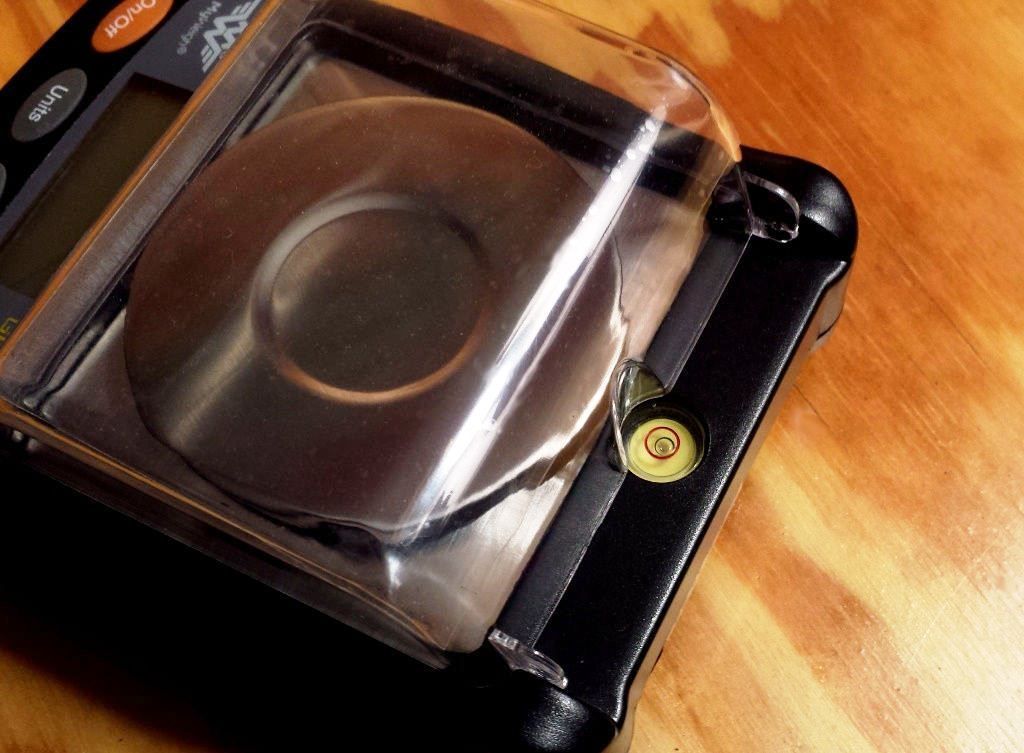 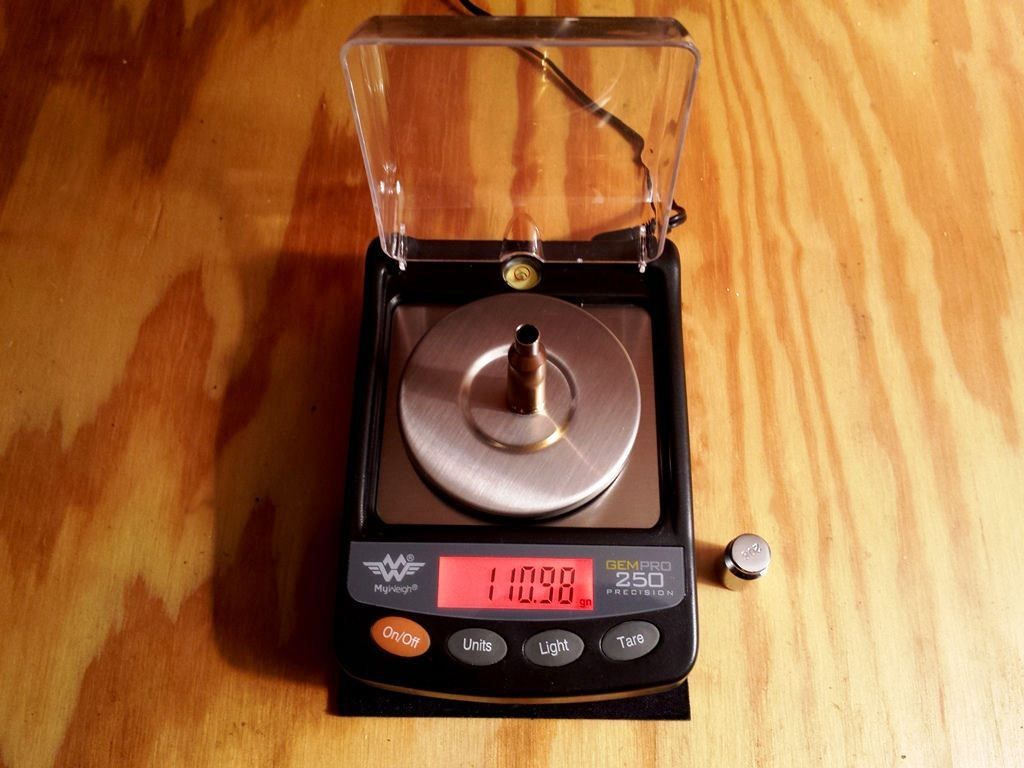 With 1,000 pieces of .220 Russian on-hand I can partition them in 0.10 grain increments. A distribution chart for one box: 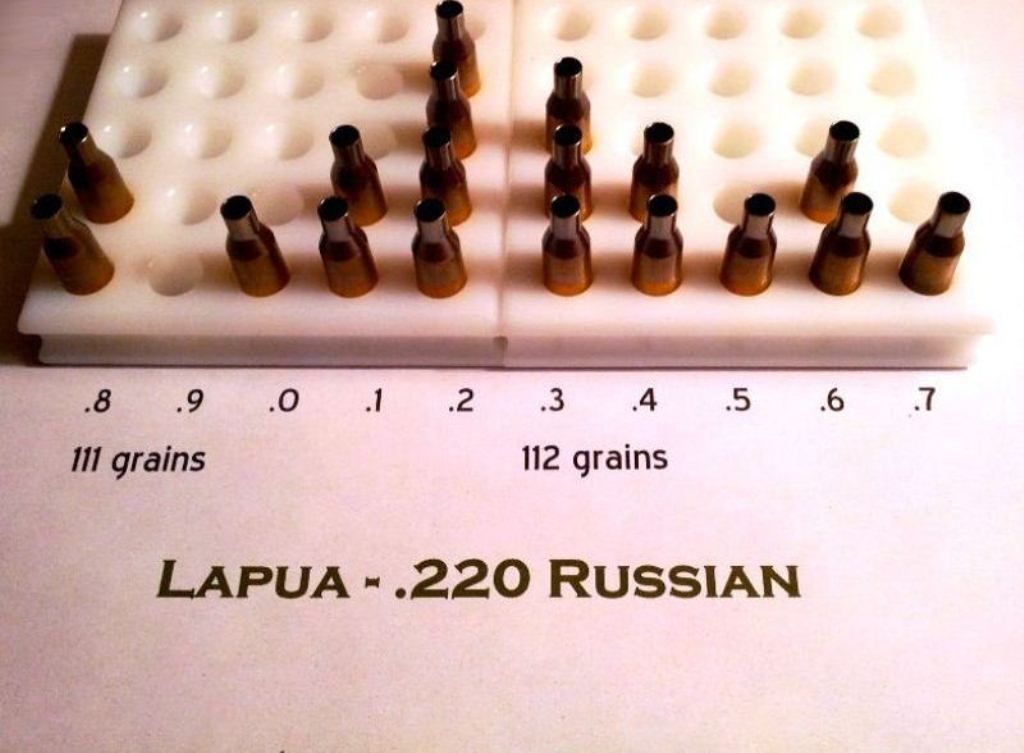 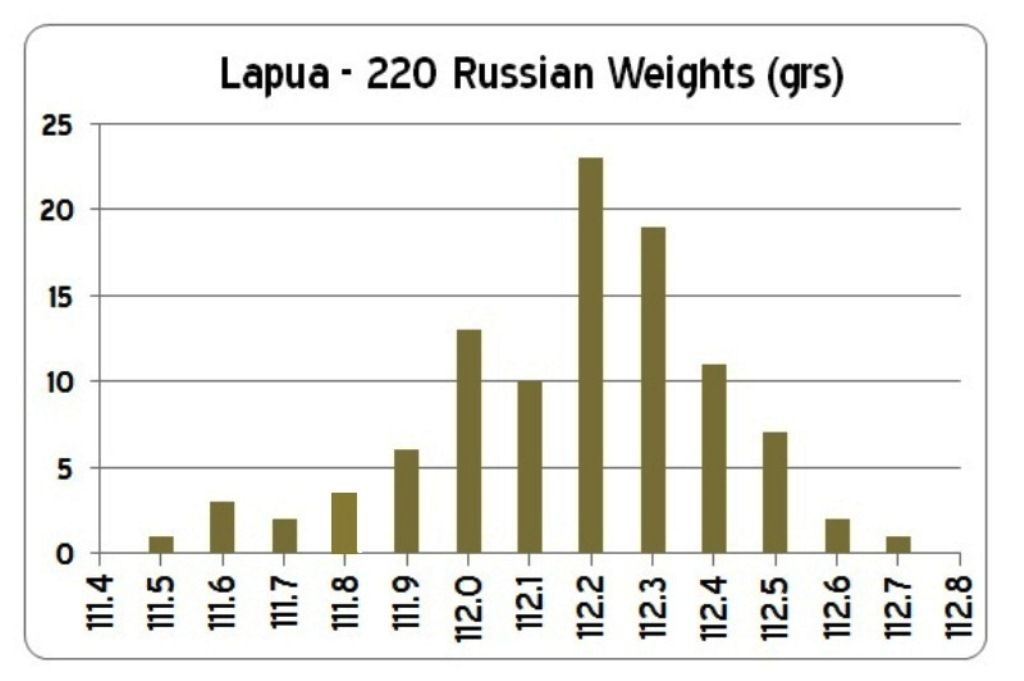 This box of fifty all weighs 112.2 – 112.3 grains. 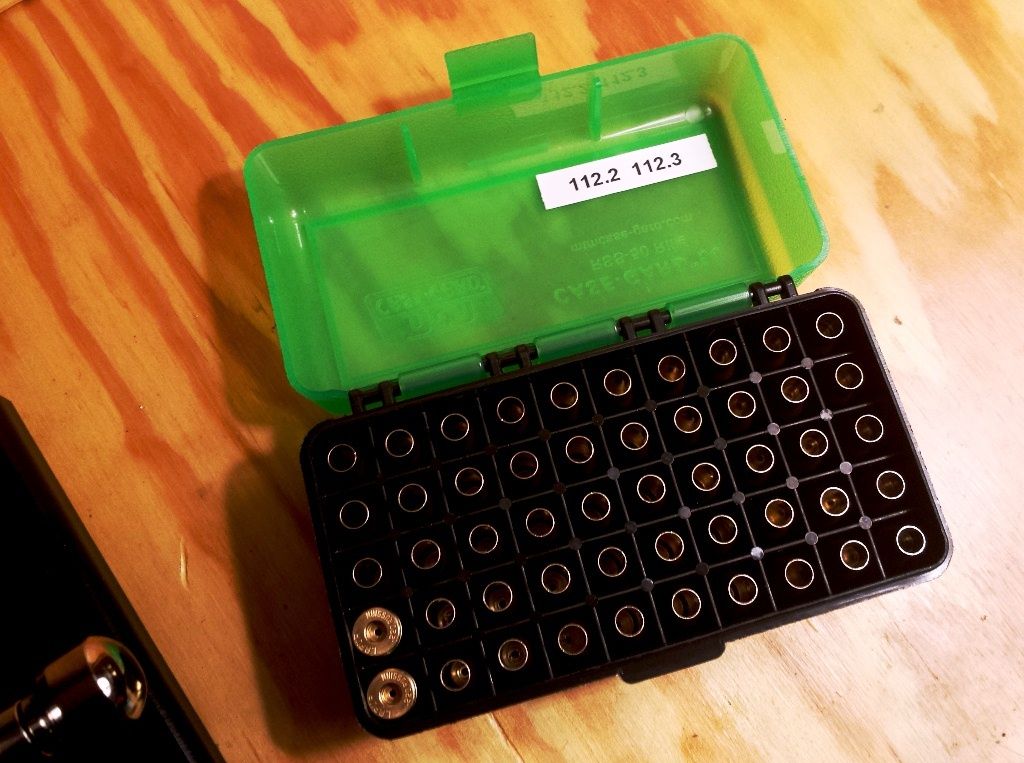 -Lee www.singleactions.com"Building carpal tunnel one round at a time" |
|
|
|
Post by Lee Martin on Apr 6, 2015 19:55:28 GMT -5
Case Forming – Step 2 ______________________________________ A pin-vise and small drill bit is used to lightly debur the flash hole: 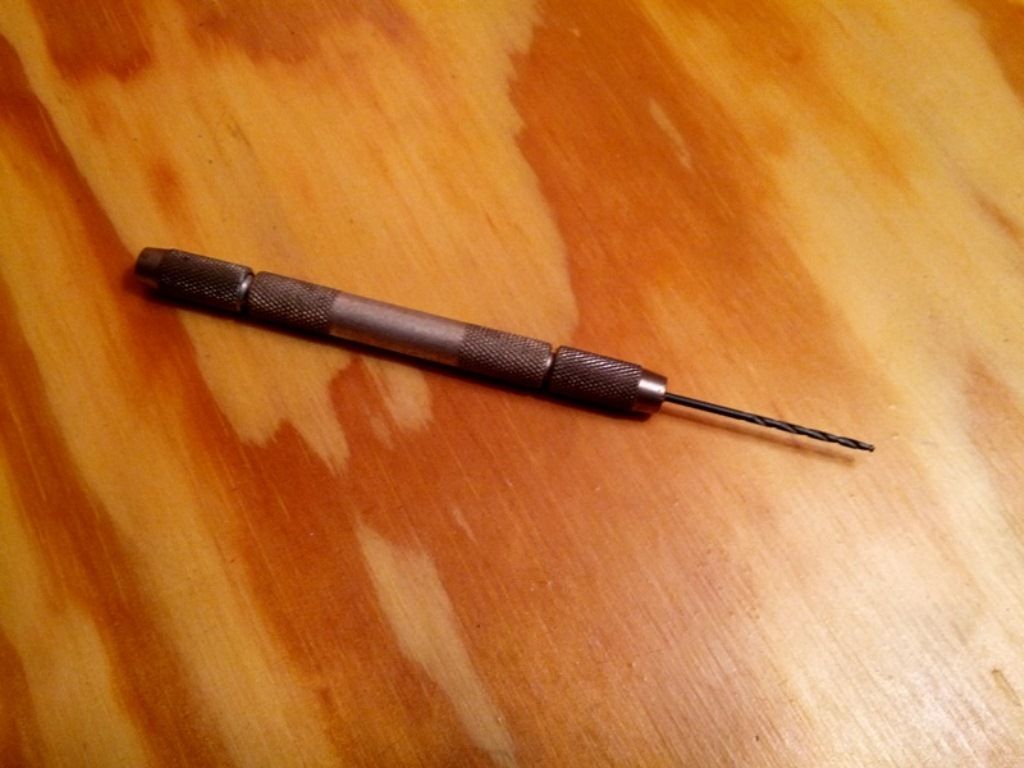  I expand the necks from .22 to 6mm on a K&M mandrel. Imperial die wax is applied to the shaft and inside the case mouth (a light film of RCBS lube works too in the neck):  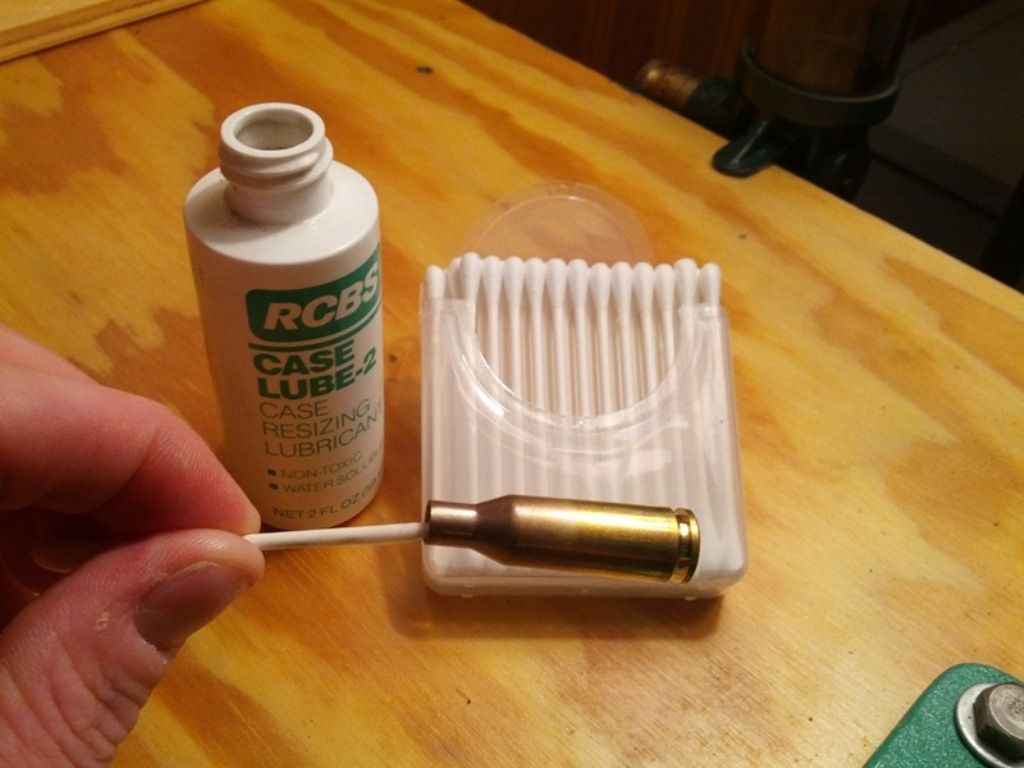 The screw stem serves as a depth stop. 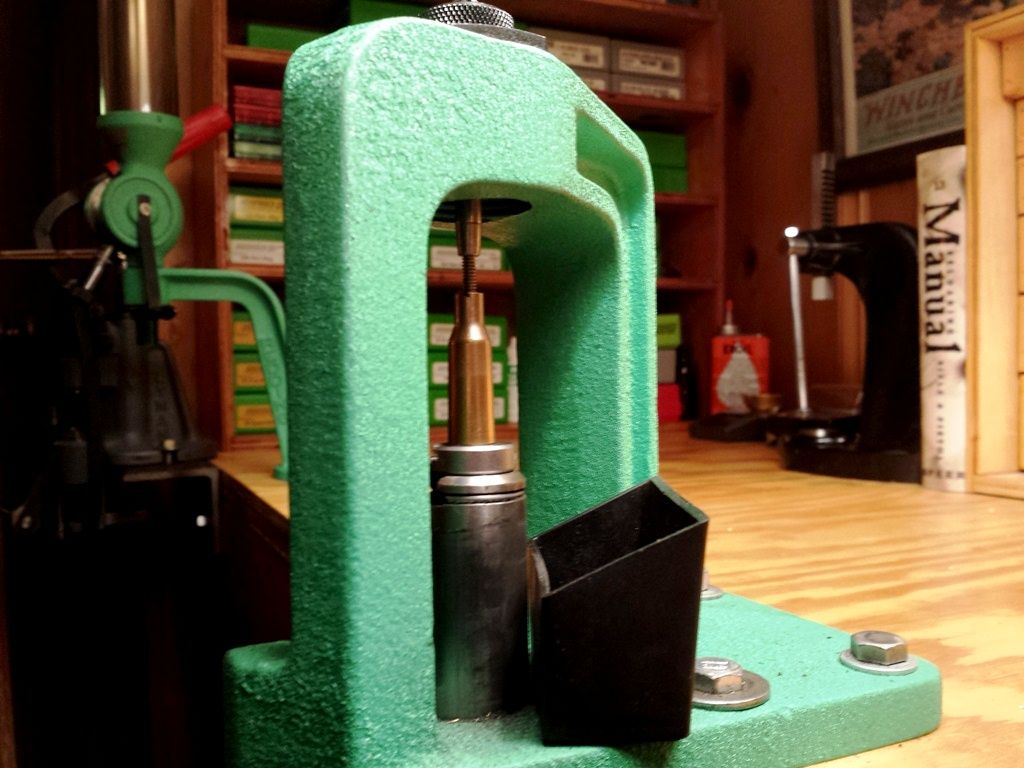 The neck after being expanded in an O-type press (Left - .220 Russian, Right – opened to 6mm): 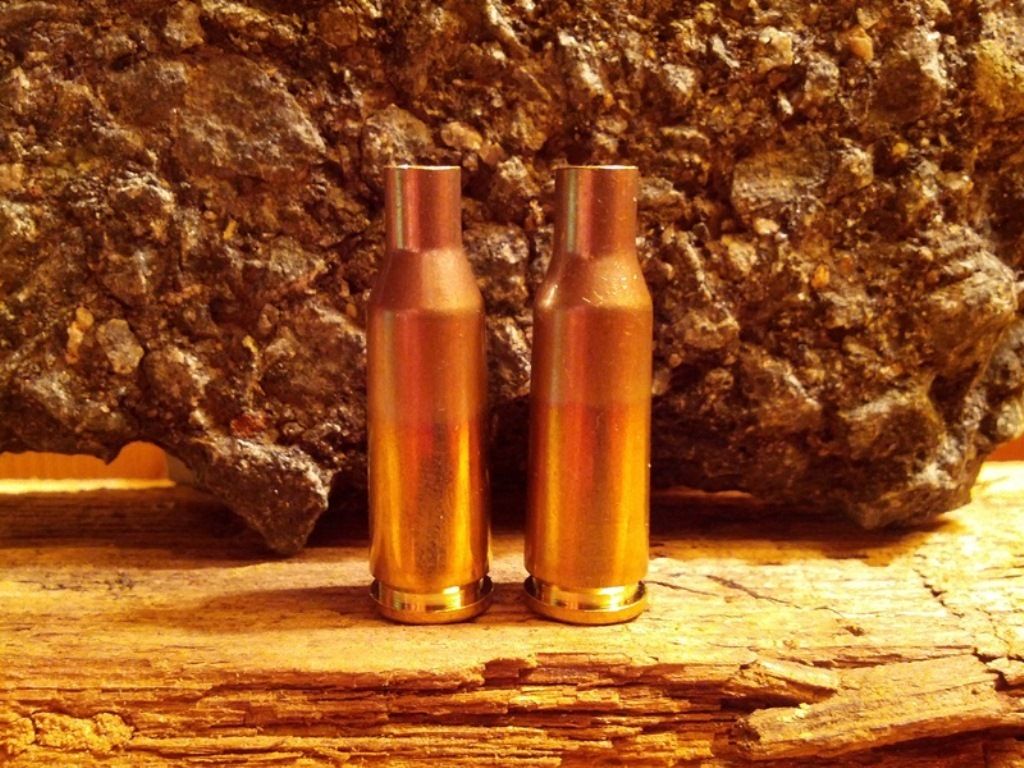 -Lee www.singleactions.com"Building carpal tunnel one round at a time" |
|
|
|
Post by Lee Martin on Apr 8, 2015 18:36:32 GMT -5
Case Forming – Step 3 ___________________________________________ As you’ll see in a minute, uniform case length is a must for accurate neck turning. The trimmers used to do this come in two styles. One indexes off the rim, the other off the shoulder’s datum line. Each has its pros and cons: Indexing off the rim: • Pros – Capable of good accuracy and the process is faster. You also don’t need cartridge specific collets, just basic shell-holders. For rifle rounds, three will cover most of your needs (’06, belted magnum, and the 223 head). • Cons – Surprisingly, the base doesn’t always stay square after repeated firings. When this happens, it’s tough to maintain consistency within a thousandth. Indexing off the Shoulder: • Pros – Indexes at the point of headspace and FL sizing. These trimmers also hold the brass straighter, resulting in much truer mouths. Some of these units even have micrometer adjustment which can be dialed to 0.001”. • Cons – Takes longer to cycle between shells and they require unique holders. Benchrest shooters generally go off the shoulder. And no trimmer has more of that market than the L.E. Wilson Company. Cases are grasped in a body collar and held against the rail by hand (or a pivoting fin with the deluxe model). The rim butts to an adjustable tail-shaft. 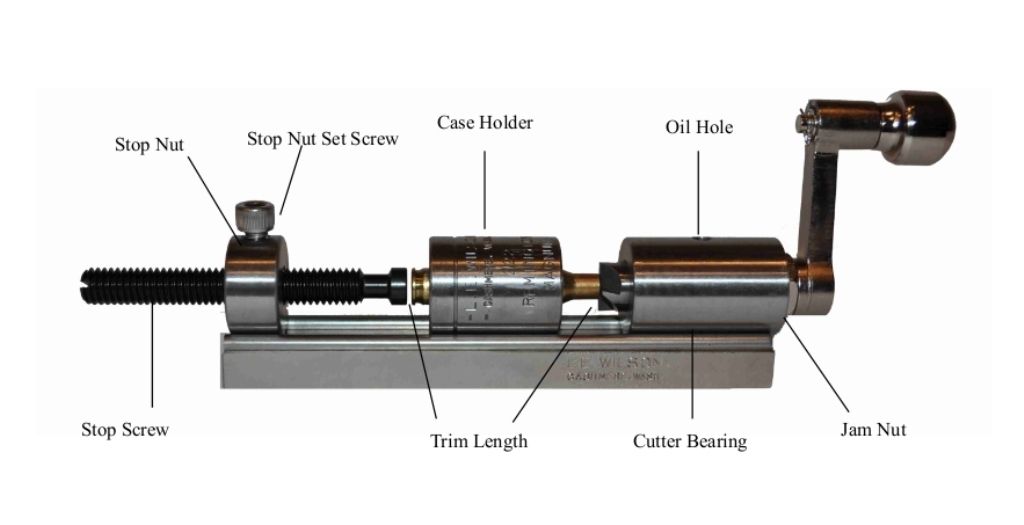 A few years ago L.E. Wilson teamed with Sinclair International and released the Ultimate Case Trimmer. Functionally, it is similar to the one pictured above but has some extras: • All stainless construction • A latch fin that seats the holder on the rail. • Final length is adjusted by a tail-stock mounted micrometer. It’ll dial in 0.001” ticks, but going between the lines nets half-thousandths • Bench stand which eliminates having to hold the trimmer in a vise. I bought one of these and my old Redding has collected dust ever since. Lapua .220 Russian measures 1.52” – 1.53” out of the box. Because the mouth sets the cutting depth for neck turning, you want precise lengths before thinning. Now what that length is doesn’t matter. All we care about at this stage is they’re trimmed identical. My first fifty, batched by weight, were 1.515” to 1.528”. Using the Wilson-Sinclair I took them down to 1.500”. Case trimmer and the tools necessary for the operation: 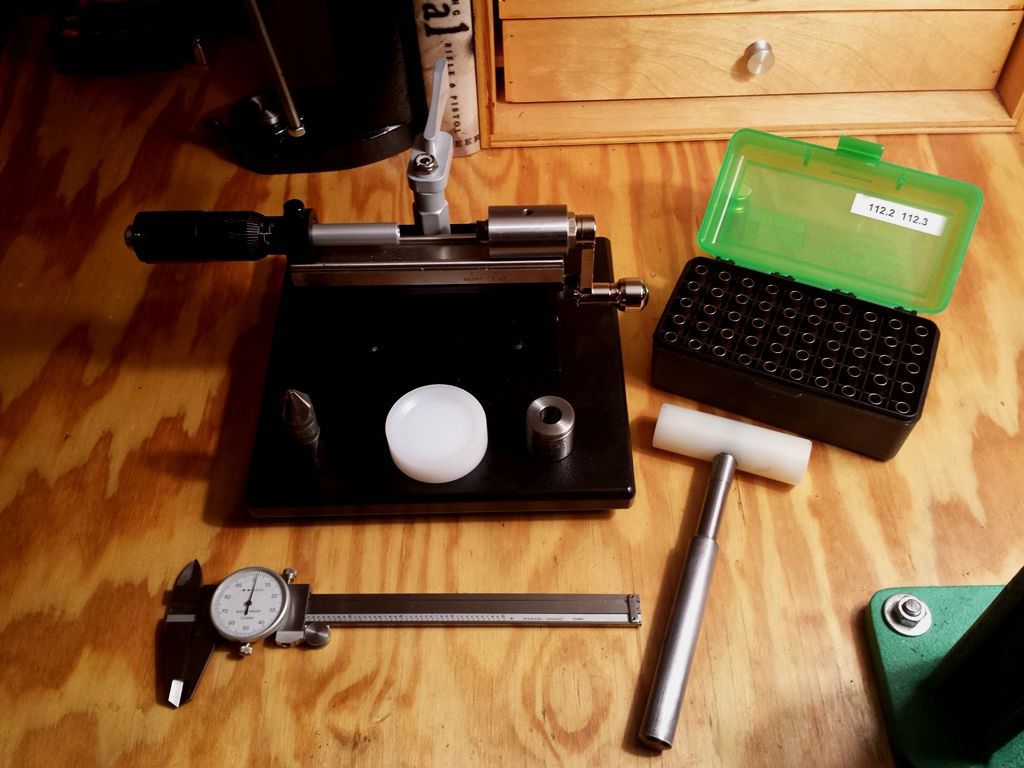 With the PPC, you need two case holders. The first seats .220 Russian ahead of fire-forming. The second is for fully formed 6 PPCs.  The back of the mounting stand has a storage area for the holders: 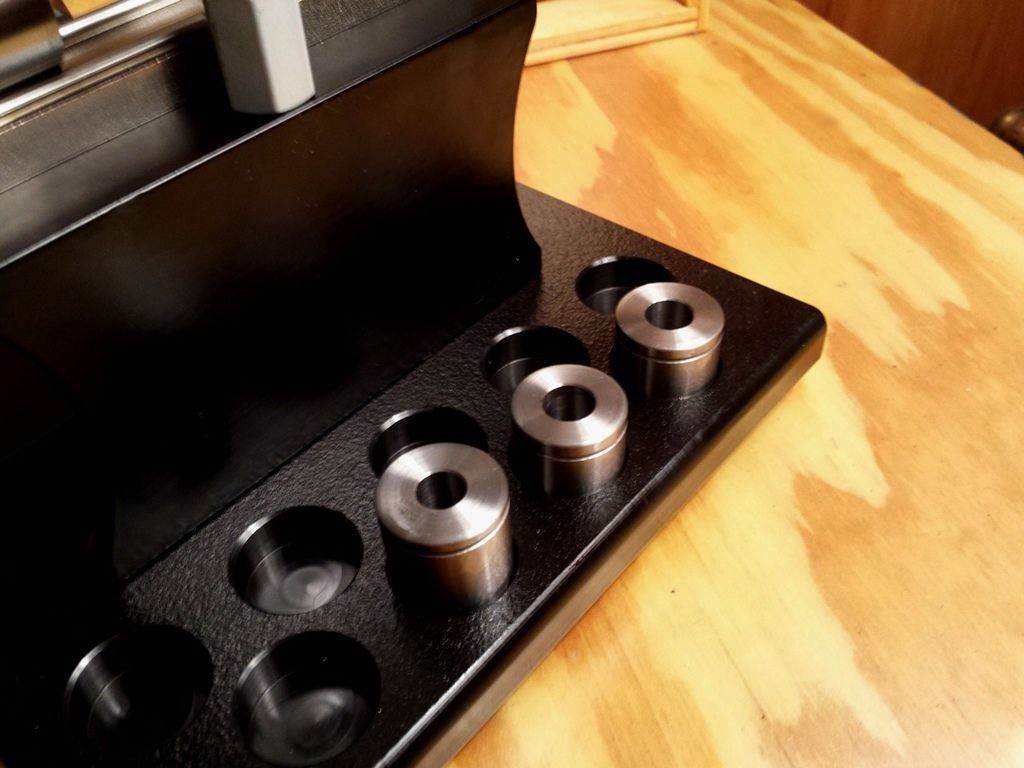 A nylon mallet taps the shell into place: 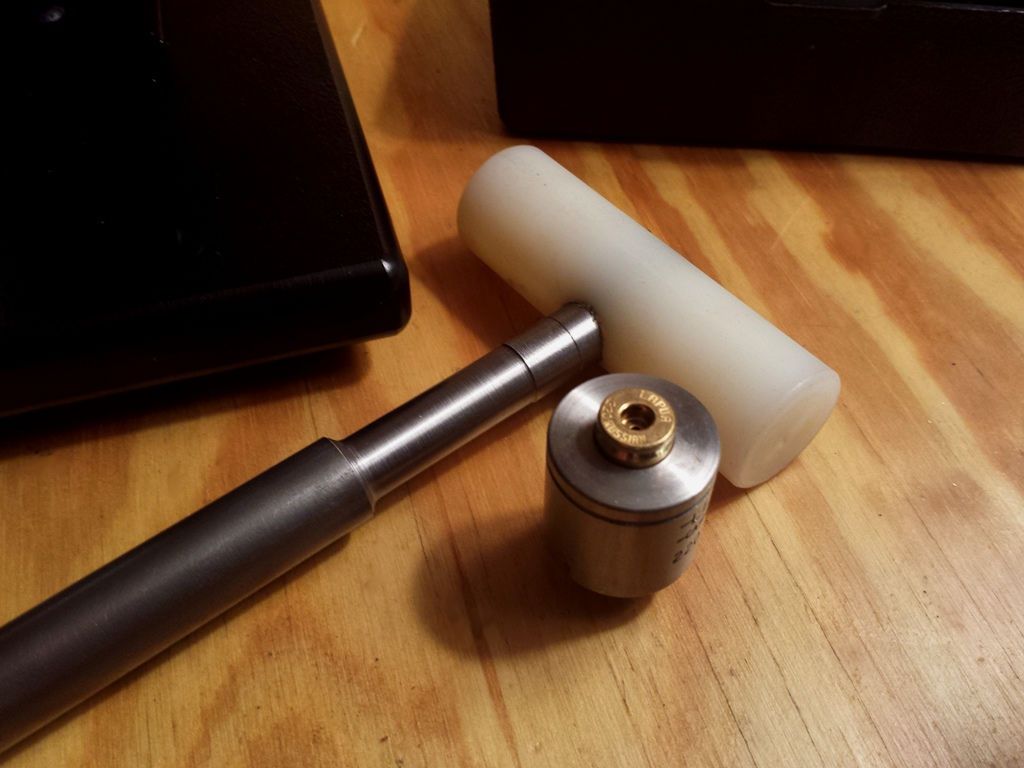 The tailstock micrometer is set for 1.500”: 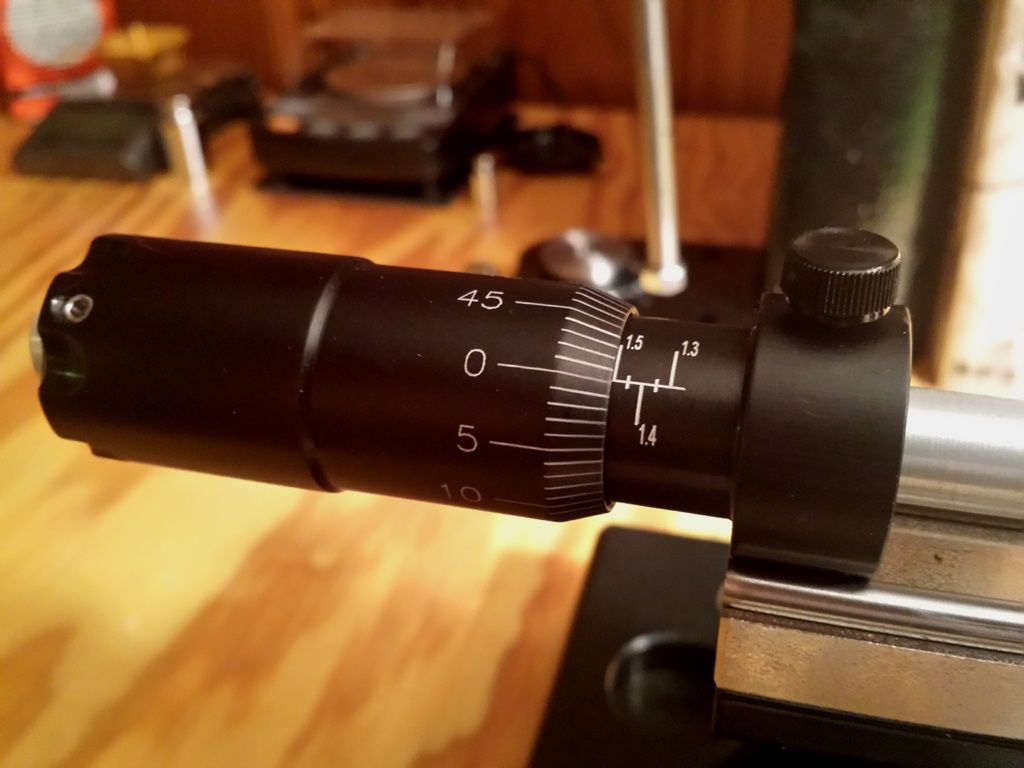 The case-holder is pinned against the locked tail shaft by the fin. Rotating the trim handle while feeding in makes the cut: 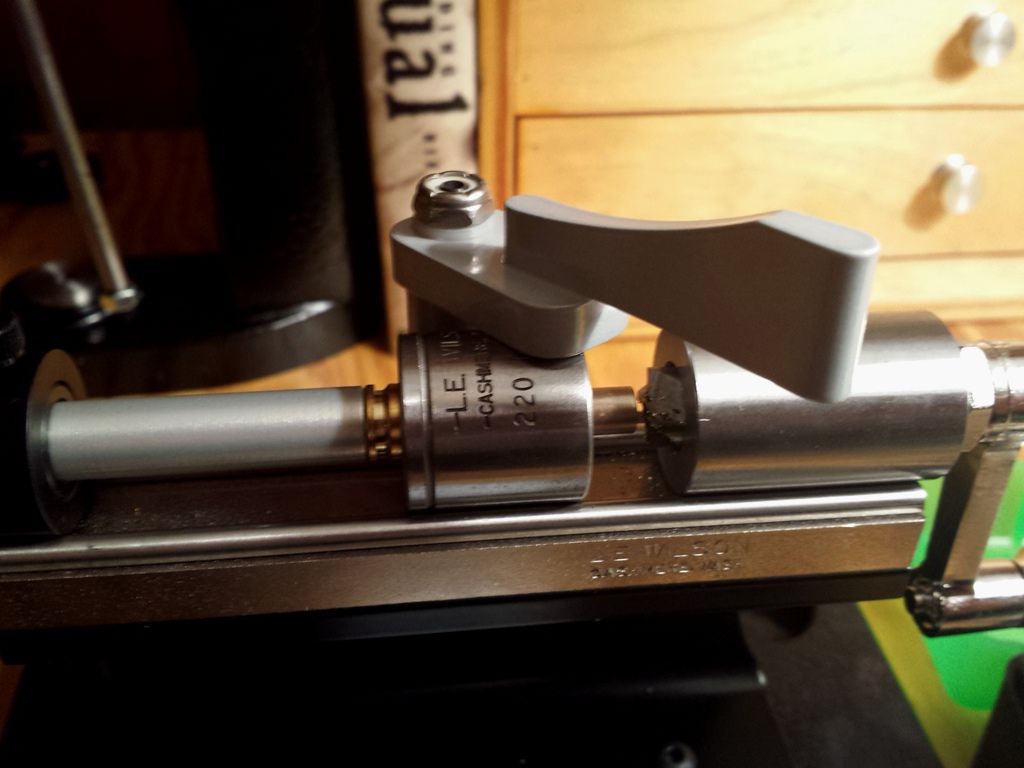 Mouths are lightly chamfered: 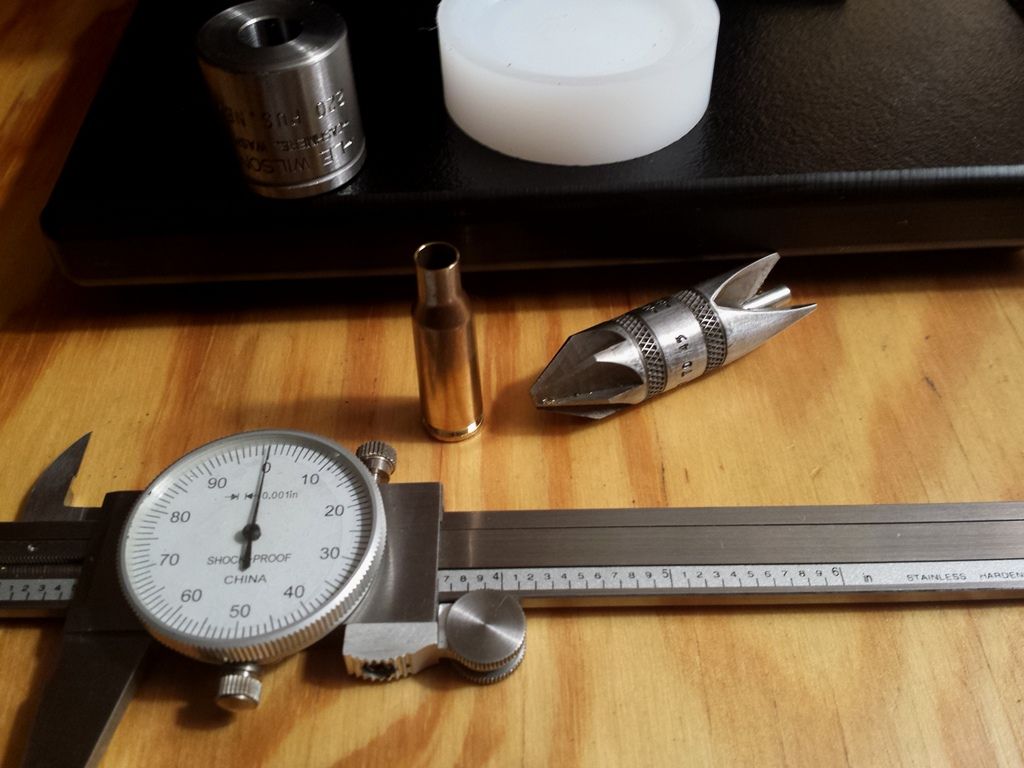 These are checked in a dial caliper. Every one landed 1.500” on the nose. 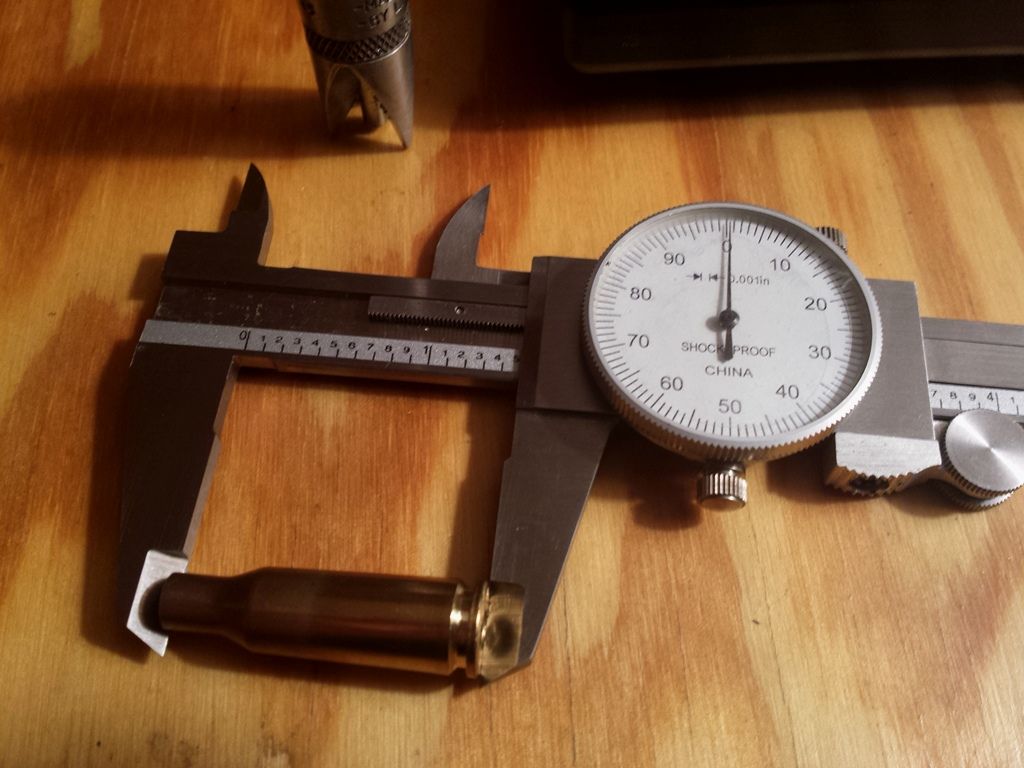 -Lee www.singleactions.com"Building carpal tunnel one round at a time" |
|
ericp
.327 Meteor
 
Posts: 521
|
Post by ericp on Apr 8, 2015 21:56:45 GMT -5
What would be the advantage to using 6.5 Grendel for forming? Just less distortion because it is being worked less to get to .30? I should have realized the throating aspect.
This thread has been fantastic. Thanks for sharing so much good information.
Eric
|
|
|
|
Post by Lee Martin on Apr 9, 2015 18:16:44 GMT -5
Eric, you're correct. Stinnett started with 6.5 to reduce the amount of neck expansion. And since Lapua produces the Grendel, there was no concern over brass quality. -Lee www.singleactions.com"Building carpal tunnel one round at a time" |
|
|
|
Post by Lee Martin on Apr 9, 2015 18:23:59 GMT -5
Case Forming – Step 4 _________________________________ Precision minded shooters have been turning necks since the 1940’s. The procedure isn’t too involved yet pays big dividends by removing neck run-out. Run-out you say??? And how common is that among factory brass? Basically it is seen along two dimensions: 1) Wall thickness, and 2) The shell’s centerline axis. Neck turning addresses the first and results in uniform purchase and consistent bullet tension. By doing so it also alleviates #2, but sizing technique is a factor. Most commercial brass is out by 0.002” – 0.004” around the neck. Match-grade brands average 0.001” or less. As illustrated:  The wall thickness varies from 0.0164” to 0.0132”, or three-thousandths net. When sized, the die makes the outside diameter perfectly round. The tradeoff is it pushes the unevenness to the inside edge. It’ll look like a concentric circle yet it’s offset to the centerline. The bullet then deviates from the bore axis and accuracy suffers. But wait it gets better. If your FL sizer has an expander ball it may re-orient the neck on upstroke (since the neck is already out of the die body). Luckily most expanders have a little float built into them so they self-align on the mouth. If not it'll revert to the initial 0.003” o.d. wobble. Kinda like a dog chasing his tail isn’t it? Checking a neck on a concentricity gauge: 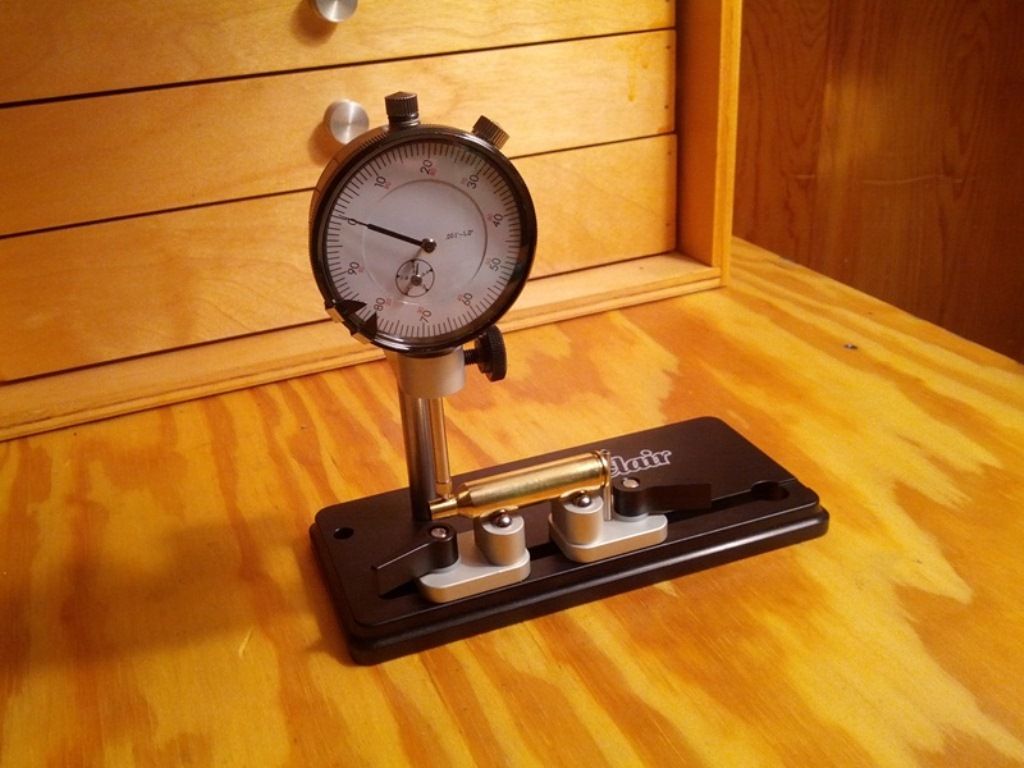 The solution is to uniform the wall thickness. There are two ways to do this and the first is the most common. By turning the outside surface we're able to remove the high spots and get precision within a few ten-thousandths. You'll also notice we went 0.0005" more than the low 0.0132”; most do so to guarantee clean-up. The second, and less prevalent method, is inside reaming. The problem with this technique is reamers follow the hole. They’ll cut 0.004” but that amount may be equally applied to the sidewalls. If a boring bar is used or the neck and body are held firm in a centering device, then you can inside ream. No matter how you get there, turning will increase chamber clearance. To circumvent this I use finishing reamers matched to the turned diameter. Deriving chamber clearance - My reamer cuts a 0.264” neck and Lapua mics 0.0135” wall thickness on average. Quick math tells us - (0.0135” x 2) + 0.2435” = 0.2705”. Clearly the round won’t chamber without neck turning. Load strategies have shifted in the past 20 years. Back in the 90’s it was hip to run total clearance at or even under 0.001”. Lately competitors have relaxed that to 0.002” plus. The verdict is still out on which promotes repeatable bullet release. I’ve decided on 0.0015”, or a loaded neck equal to 0.2625”. We start by measuring my bullet’s pressure ring: 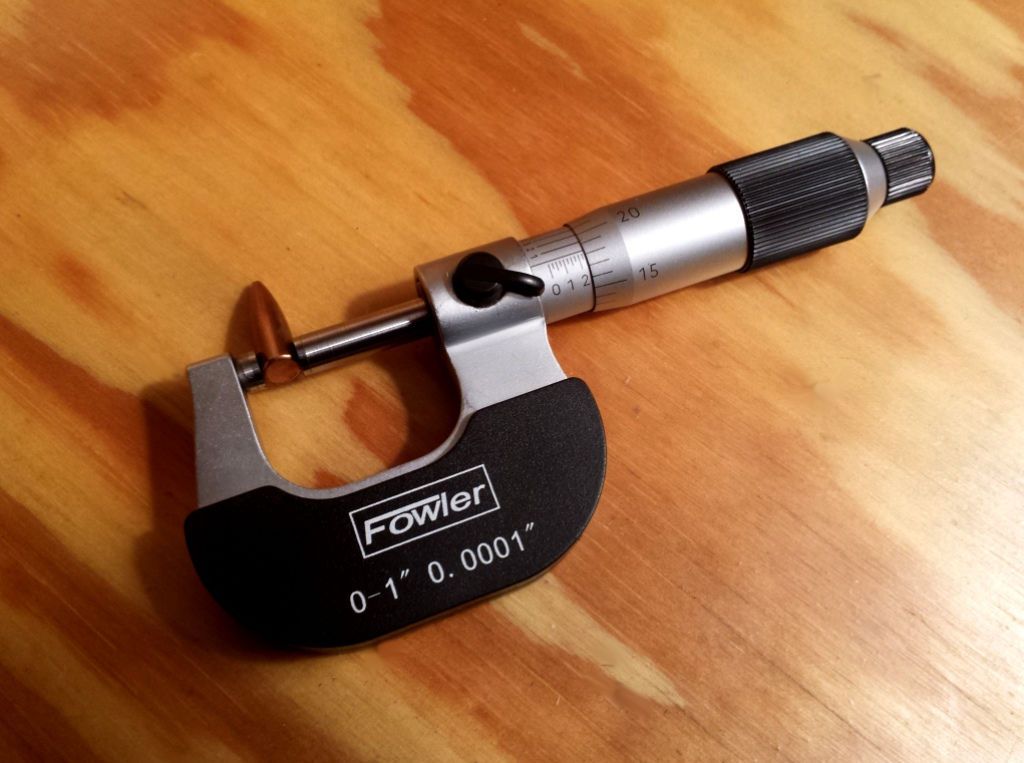 Reversing the above equation: (0.2625” – 0.2435”) / 2 = 0.0095”. Notice how we’re four digits past the decimal? We’re dealing in ten-thousandths here. Traditionally dad and I have turned necks on a lathe. Spinning them on a chucked mandrel is faster, cleaner, and dead rigid in-line. Below you’ll see this illustrated on a Harrison lathe: 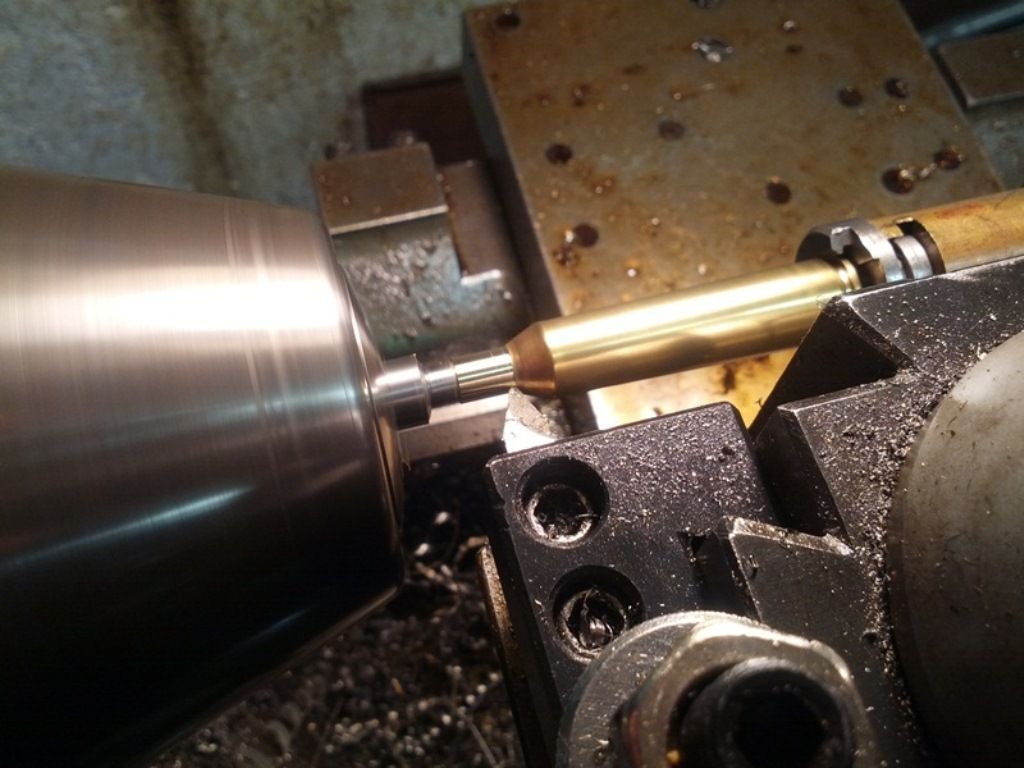 But the problem with lathes is their feed settings. Nearly all models read to thousandths. To get to tenths we attach a 0.0001” accurate dial indictor to the bed. A pain in the ass step that’s required every time we turn brass. So as much as I dislike hand turners, my PPCs are done on a K&M: 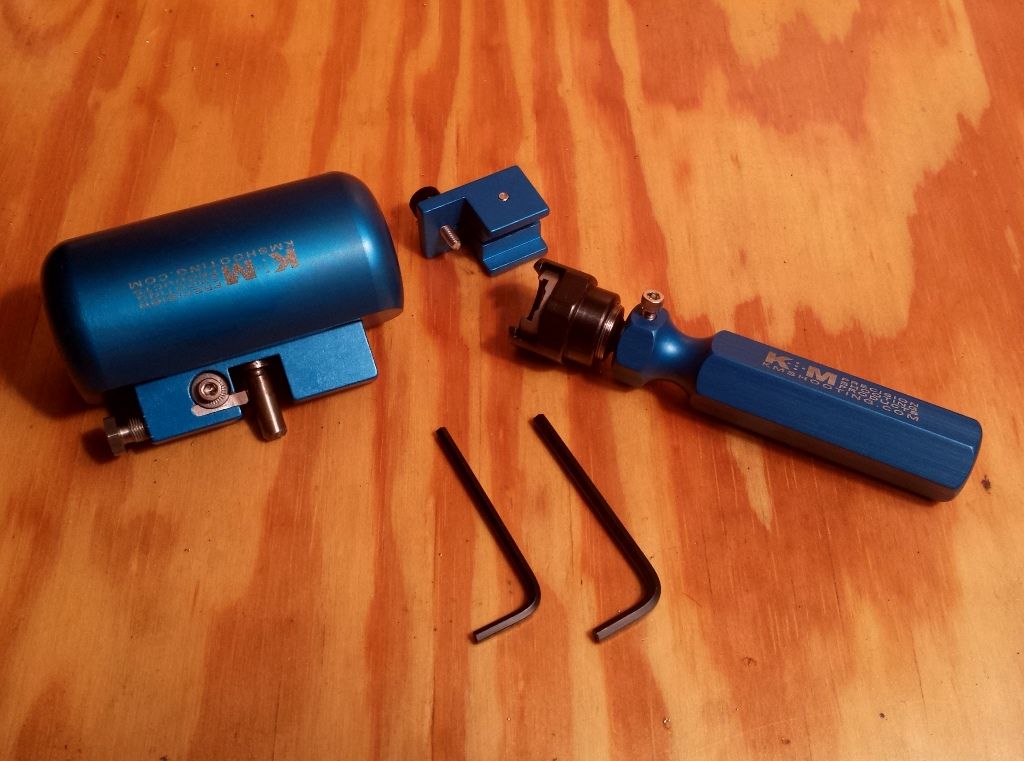 The cutter and the mandrel are carbide, which generates less heat and increases longevity: [  A shot of the cutting depth adjustment and the tool inserted in its handle. Each tick on the dial is 0.0002" on the cutter. Splitting the ticks allows you to fine tune in 0.0001" increments:  The mandrel and inside of the necks are lubricated with Imperial die wax: 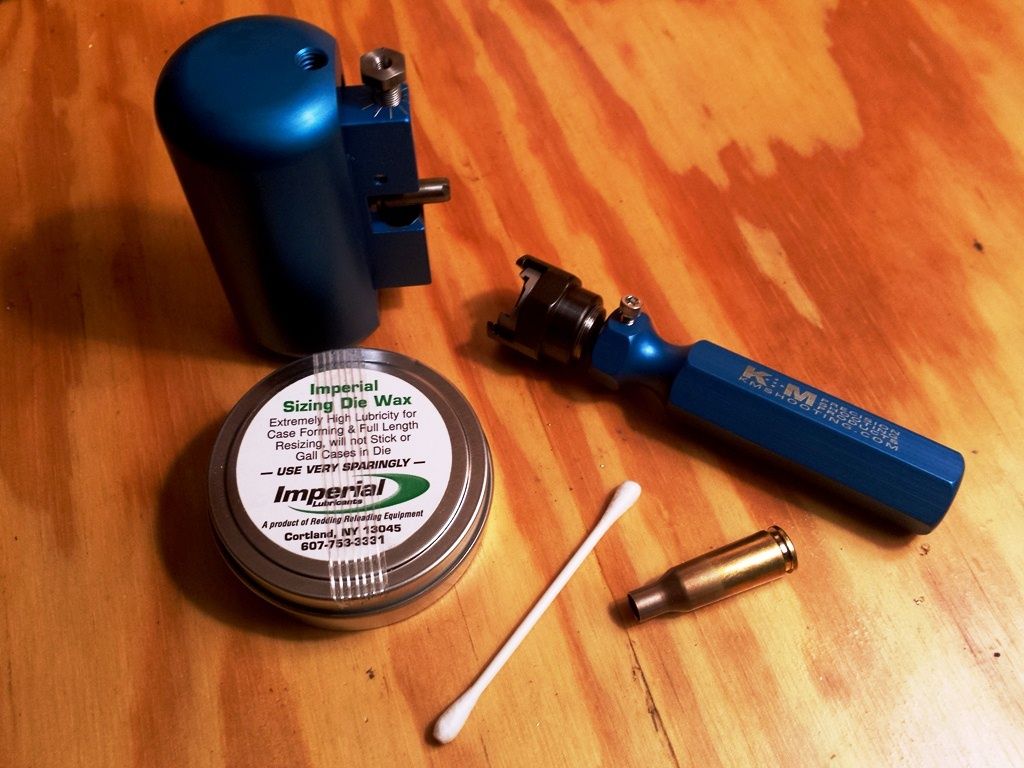 PPC shells are firmly pressed in a shell-holder and then slid onto the mandrel: 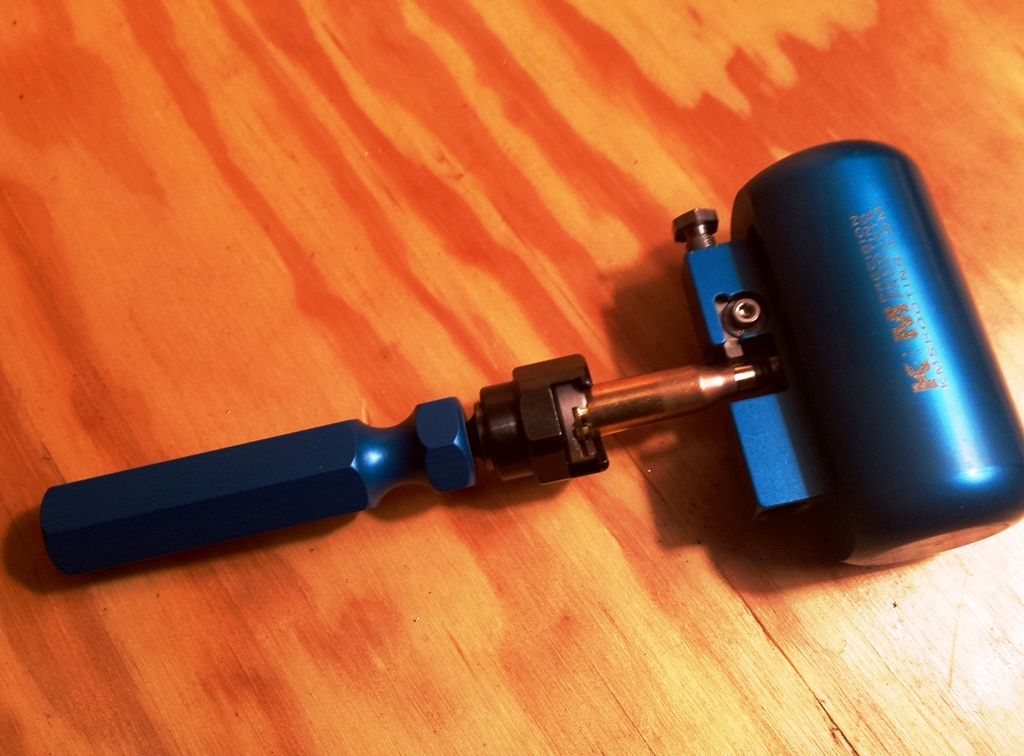 A close-up of the turning itself: 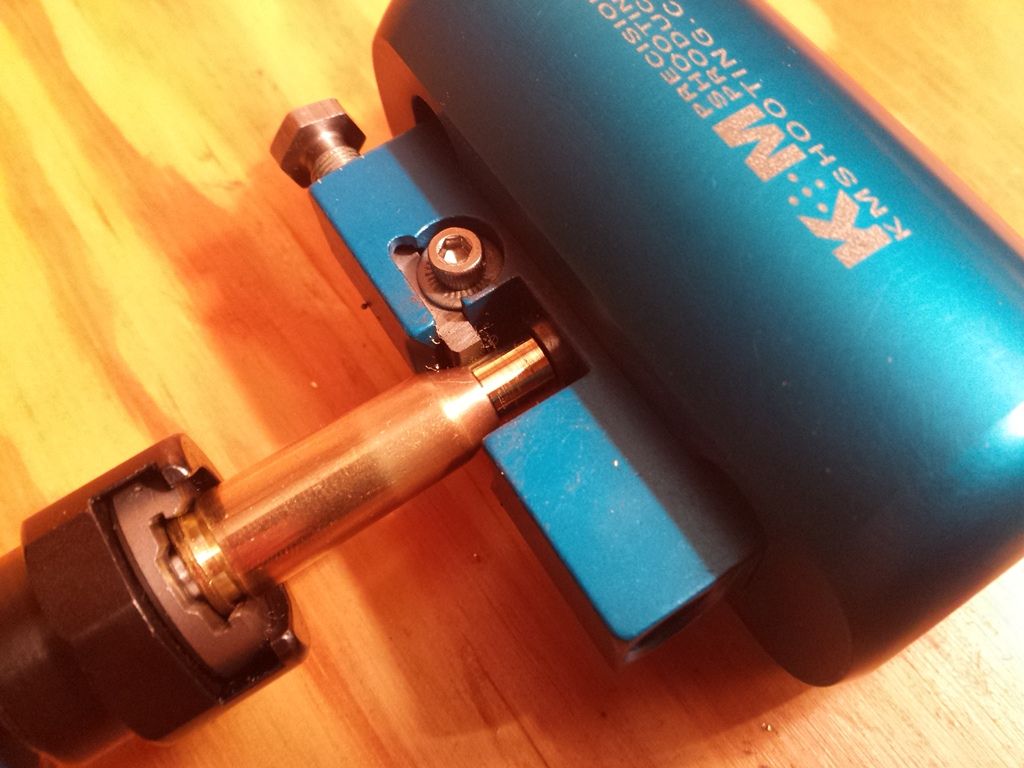 I was pleased that all 0.004” could be taken in one pass (0.0135” to 0.0095”). A lot of guys do it in two, but then again they thin for 0.262” necks. That necessitates a 0.0082” – 0.0088” wall so maybe I’m right on the edge with 0.0095”. Doing this by hand takes 2 -3 minutes per shell but the results are exact. Afterwards I lightly polish them with 0000 steel wool and tube mic the walls. Thus far I’ve turned 100 and they measure a perfect 0.0095”. Variation is well under 0.0001”.  A shot of five turned, but not fire-formed, 6 PPCs:  -Lee www.singleactions.com"Building carpal tunnel one round at a time" |
|
|
|
Post by Markbo on Apr 9, 2015 19:50:06 GMT -5
Un
Be
Leevable!!!
The education factor of all of this extraordinary. I am serious....it is book worthy. Why dont you start a new thread from here on...maybe in reloading?
|
|